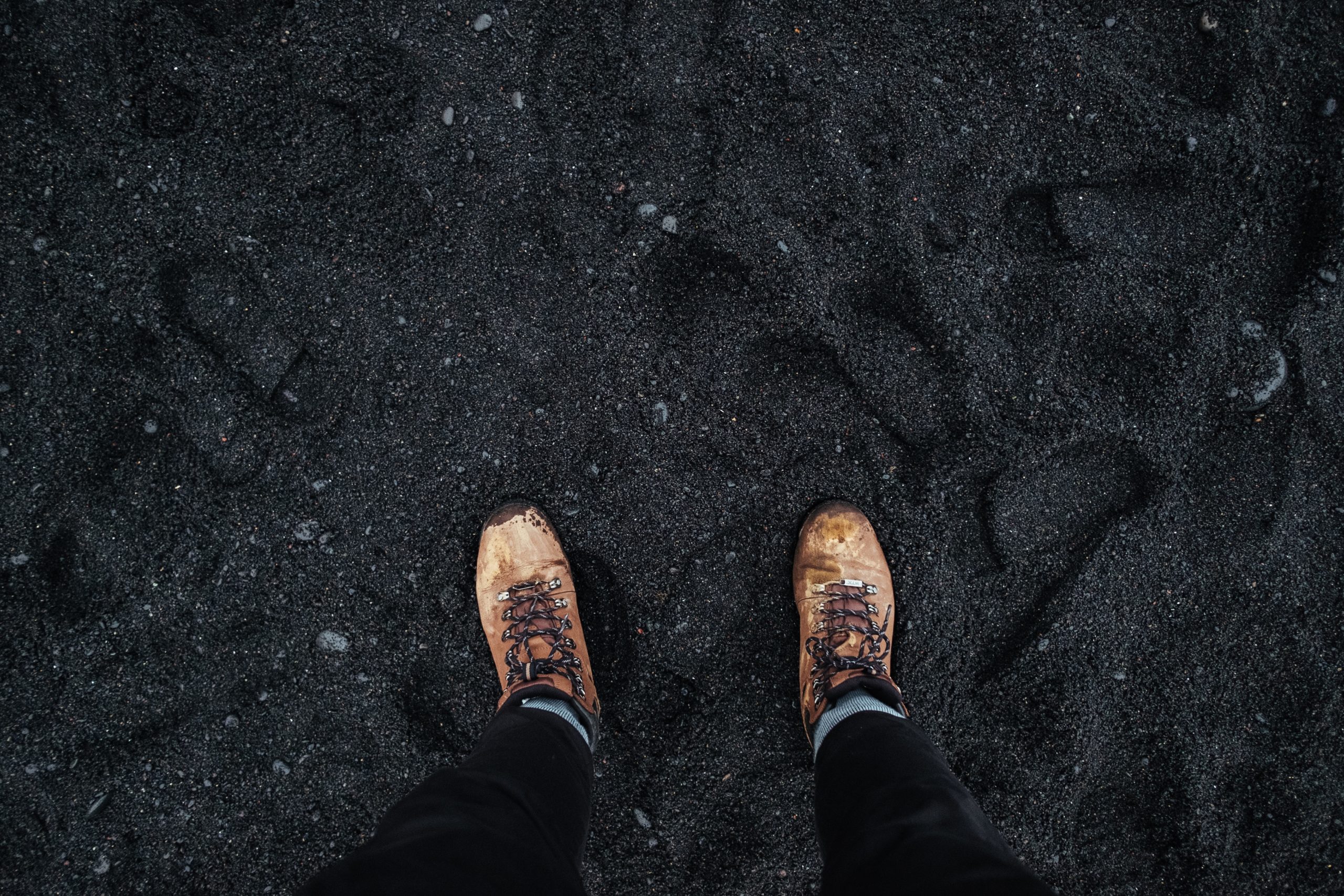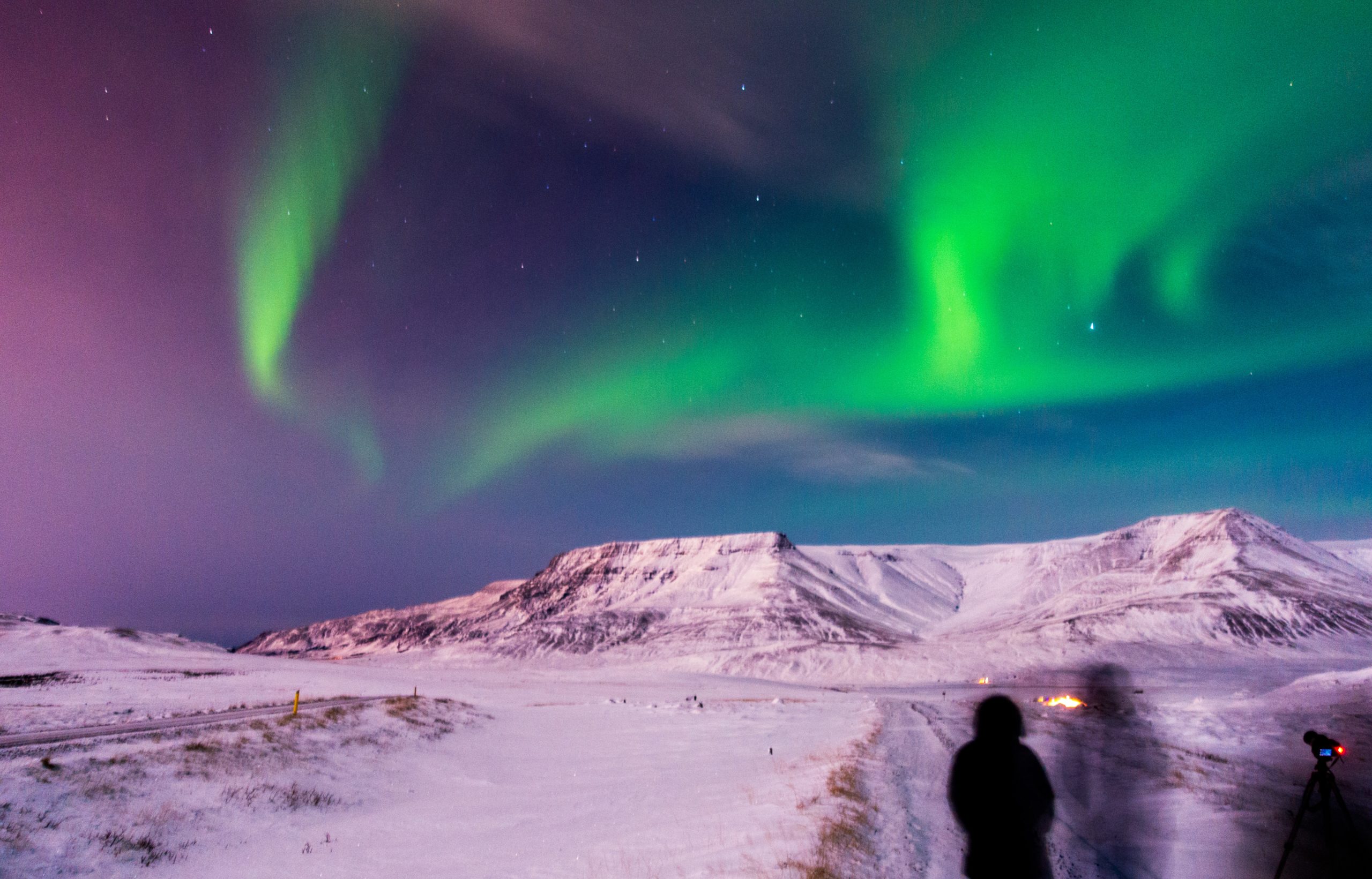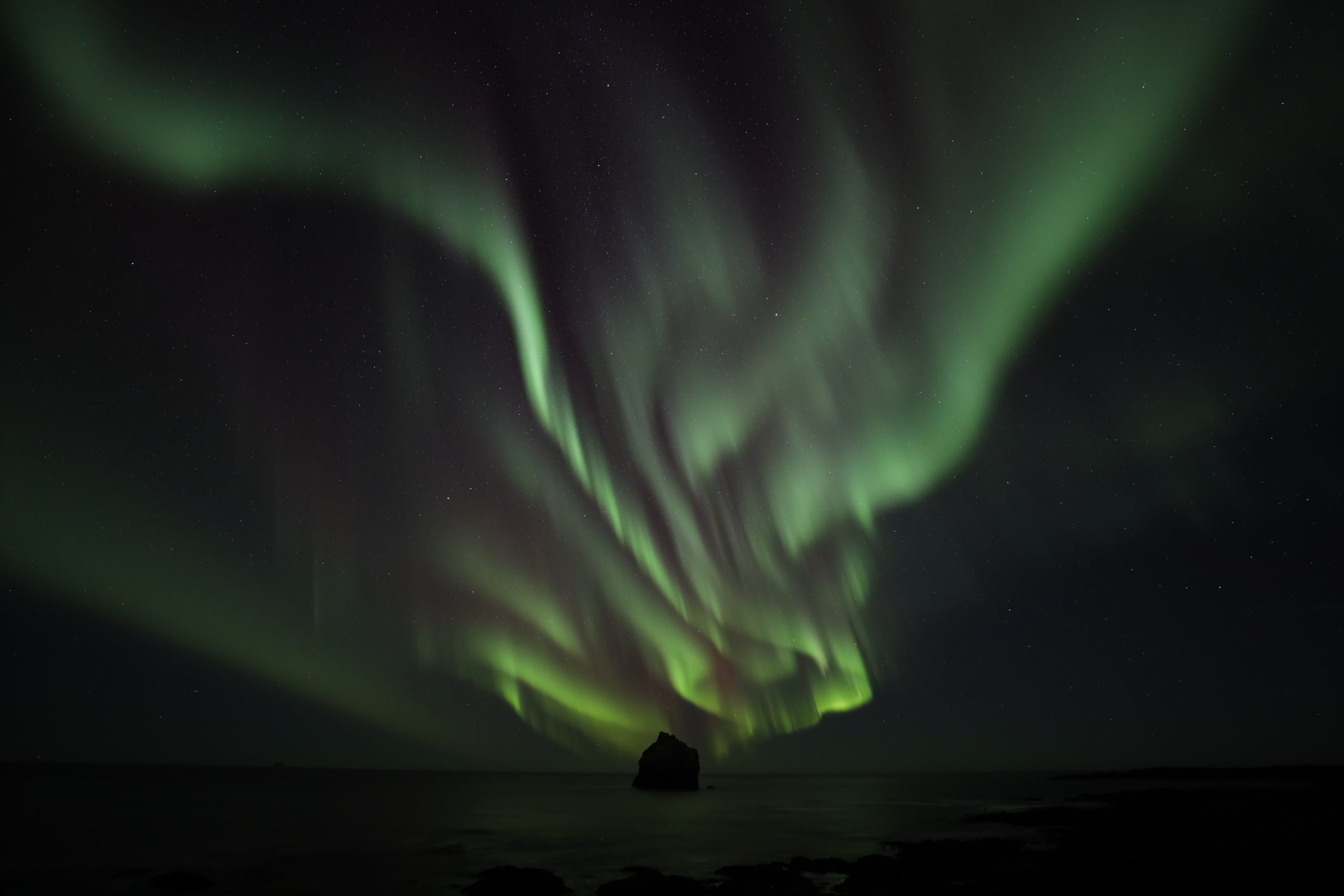Destination black sand beach Iceland: 10 of our favorite unforgettable beaches to watch the northern lights from
If you’re looking for some black sand to aurora watch from, look no further. With nearly 5000 km. of coastline, Iceland has you covered.
Picture it. Destination: black sand beach Iceland. Sparkling dark sand is the gift of many volcanic hotspots, but up here in the North, Iceland is among the few. Imagine the incredible darkness of sitting on the velvety black sand, while auroras dance in the black night.
Aside from the mystical moving lights, the only thing you can see are the stars and the white surf. It’s not a sight to miss, so we’ve gathered up a few of our favorites. Many things are otherworldly about black sand Iceland- but this is surely one of the most surreal.
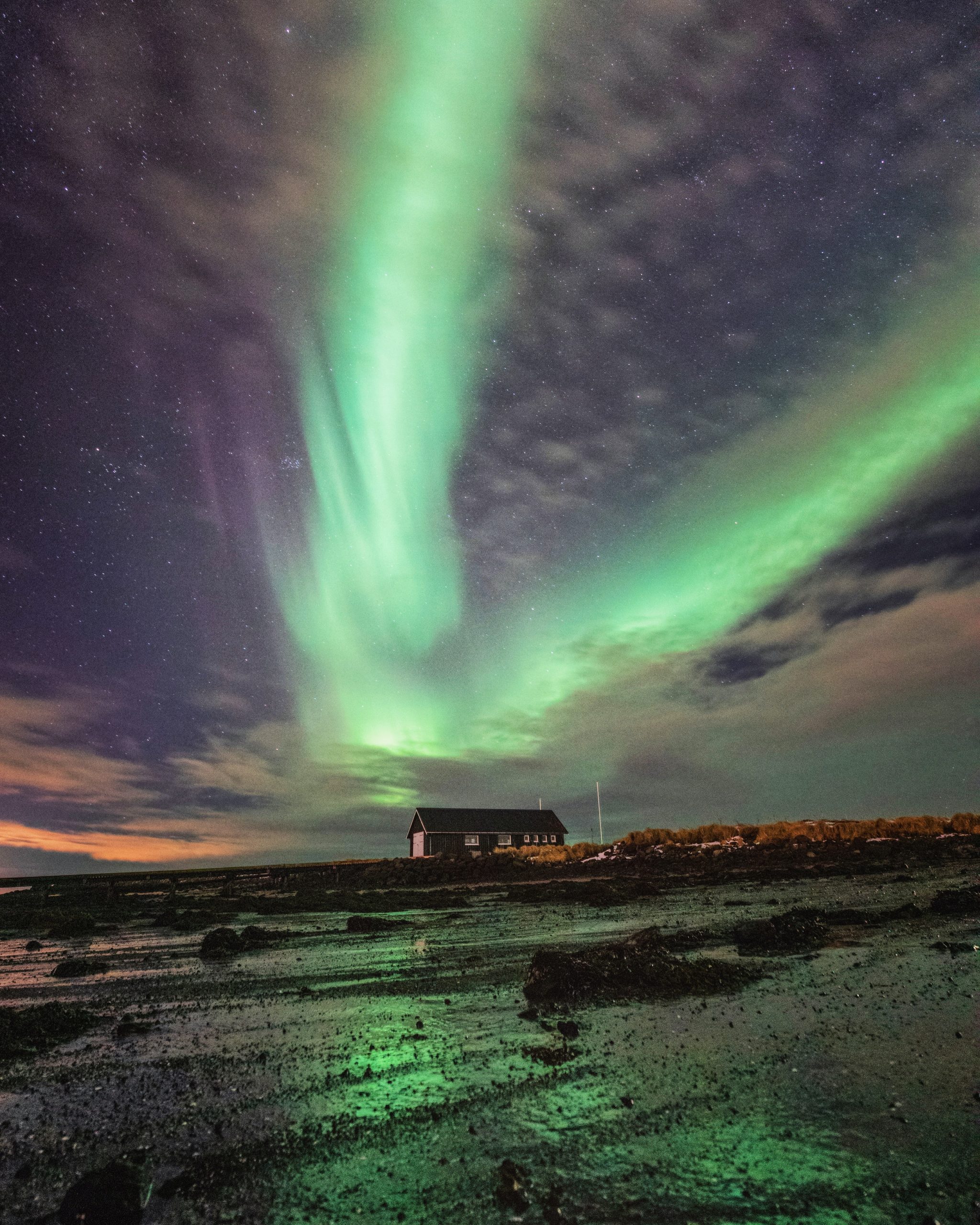
1. Seltjörn, Ægisíða, and Kirkjusandur: The City Coast
Despite Reykjavik’s cosmopolitan appearance, this is a seaside town. And with the sea, comes miles and miles of coastline. There are many places where you can’t access the water because of barriers, big rocks, or just a lack of places to stand, but these are not among them.
These three beaches represent only a fraction of the accessible coast, but they are gorgeous hideaways to stroll in the sunlight. (Or the moonlight, if you’re keeping an eye out and watching the tide.) If you’re enjoying a walk on the seafront paths, you can find Seltjörn and Kirkjusandur at either end of it.
Kirkjusandur is the closer beach to the city center, and like many city spots, depending on the tide it may or may not be there when you arrive! It is a good reminder that despite our concrete home, we are never too far from nature in black sand beach Iceland.
If you find yourself down by Grótta, you will have plenty of time to enjoy Seltjörn. The home of one of Reykjavik’s most notable lighthouses, a nature reserve, and a beloved aurora watching spot- this entire area feels lightyears removed from the hustle and bustle of the city just behind it.
And if you find yourself in Reykjavik’s cozy Vesturbær neighborhood, you can enjoy a walk down Ægisíða. An area of trails and recreation, Ægisíða is a tiny stretch of shore dotted with fisherman’s huts and reminders of a time when a day’s work was a good catch and a small boat.
On a clear day, you can see all the way to Reykjanes from this spot. There are many tiny beaches in the city, some of them with no name at all.
They are all different windows into what life used to be like, with different gifts like sea glass, urchin shells, and long strands of luminous seaweed decorating their shores. And if you’re careful, each one of them is a glorious place to watch for northern lights.
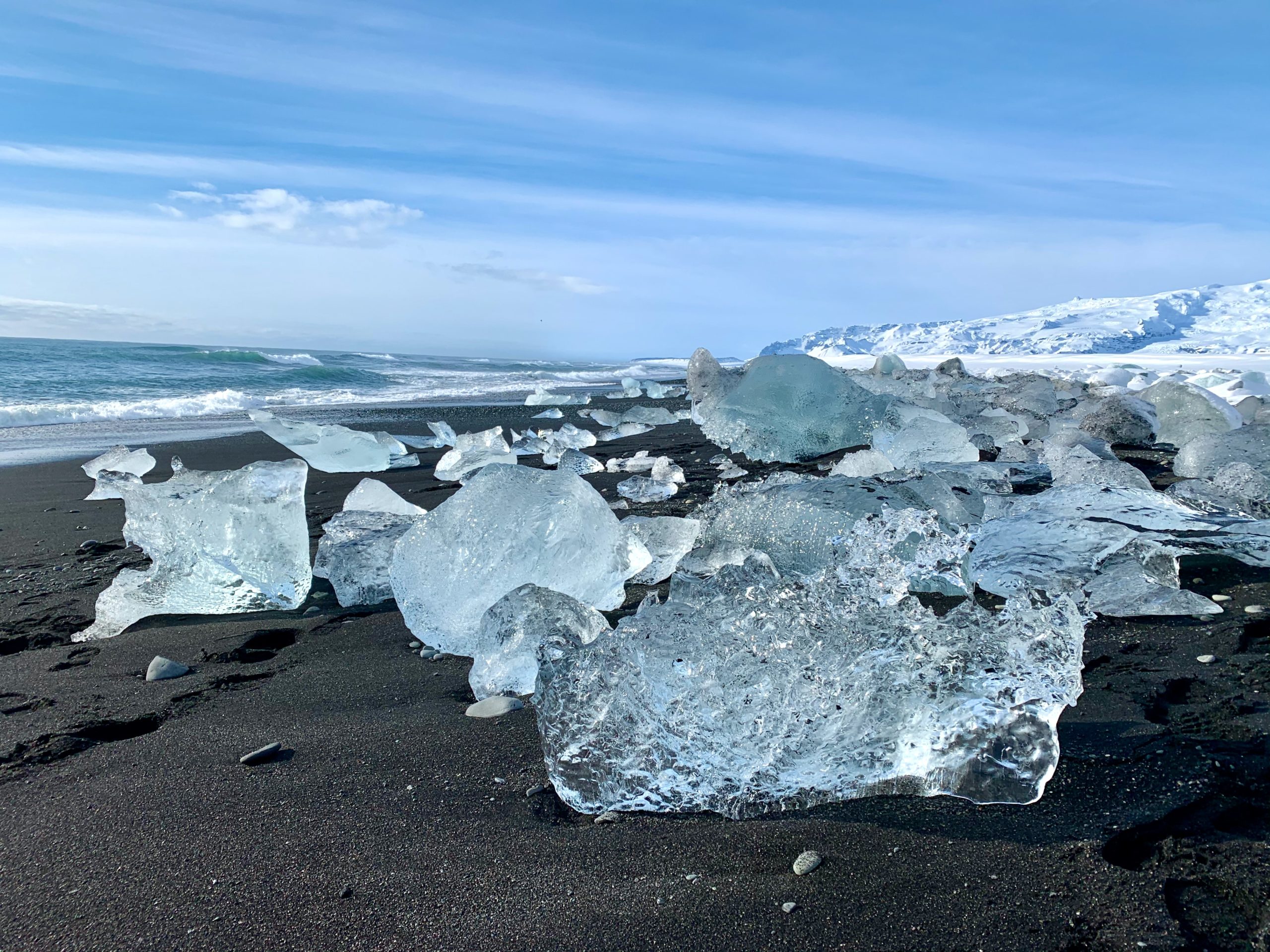
2. The world-famous Diamond Beach, also known as Breiðamerkursandur
When reading about black sand beach Iceland, it’s hard to miss the glory of Diamond Beach. A small piece of the larger Breiðamerkursandur coastline, this is a popular spot. Though it’s a bit of a drive from the capital this is the home of the Jökulsárlón glacial lagoon, and it is from there that the diamonds are provided.
This area is fed by the glacier Vatnajökull, which is so big that pieces of it have their own names. This part of the glacier is called Breiðamerkurjökull. As pieces of ice calve off of the glacier, they fall into the Jökulsárlón lagoon.
From here they travel out to sea, sometimes finding themselves festooned upon the beach there. These enormous chunks of ice bob up and down in the waves, heavy when they’re on the shore, but light as air when they’re being thrown about by the waves.
If you’re visiting black sand beach Iceland- you simply cannot miss a night spent among these titans. Black sand, chunks of ice as big as a man, and the lights coming down to dance on the lagoon.
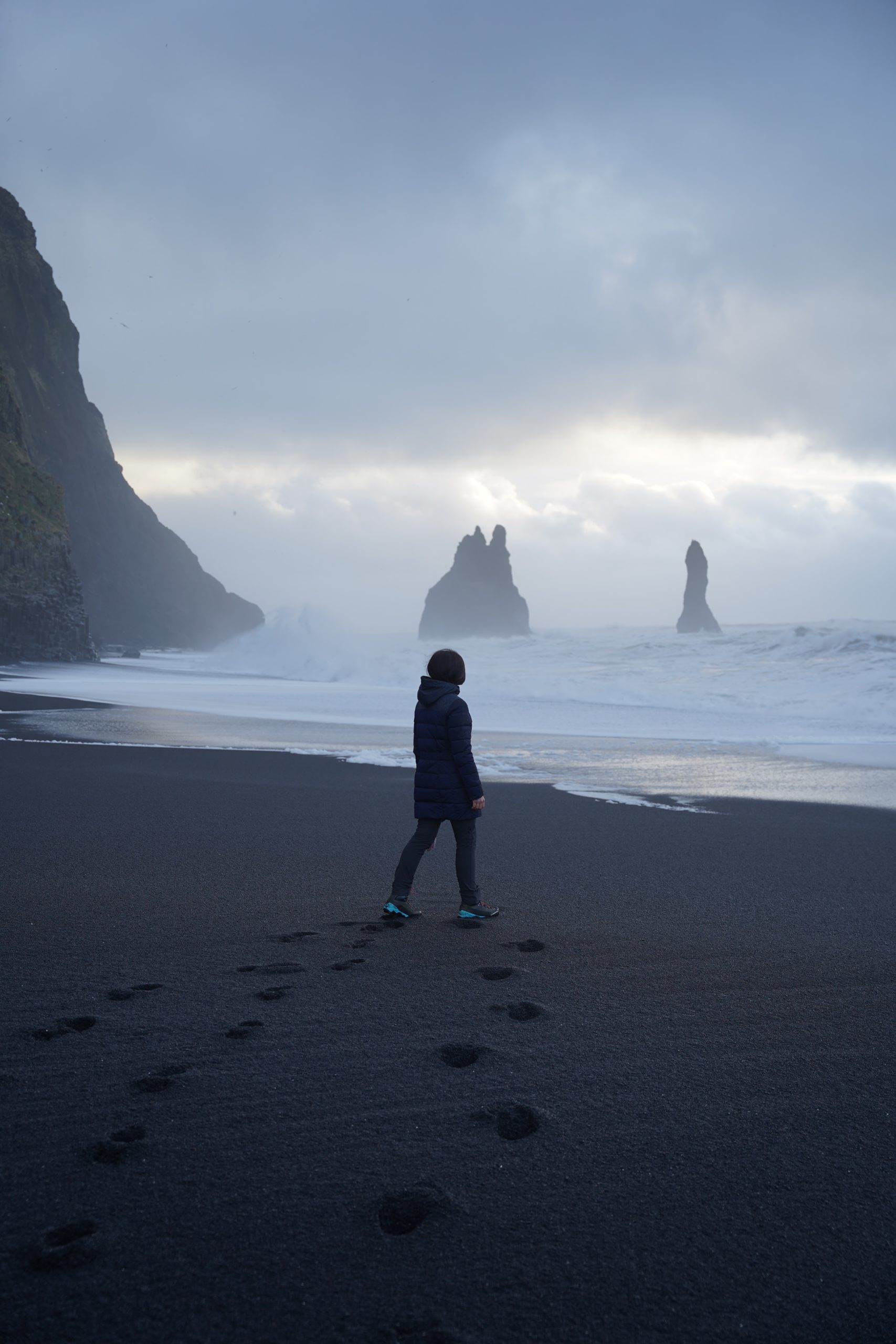
3. Reynisfjara: The postcard beach
A trip to black sand beach Iceland can’t happen without a stop on Reynisfjara. Charting as one of Iceland’s most dangerous beaches due to strong currents and sneaker waves, this beach in front of Vík has been featured in countless films and television shows.
Instantly recognized by its huge basalt caves, rock stacks, and the Dyrhólaey promontory. Iceland’s south coast is one long stretch of beaches and sand deserts. Many of these formed because of powerful volcanic eruptions and the glacial outburst floods (or jökulhlaup) that they created.
Reynisfjara is a great spot for grabbing a bite to eat or staying the night. If you plan to aurora hunt from here, make sure to keep a safe distance from the water. This beach is not staffed and getting caught in a sneaker wave can be deadly.
Fortunately, the town is right up on the beach, and you can watch the aurora from a cozy little bench among the dunes, while you listen to the crashing of the big waves on one of the most famous spots in all of black sand beach Iceland.
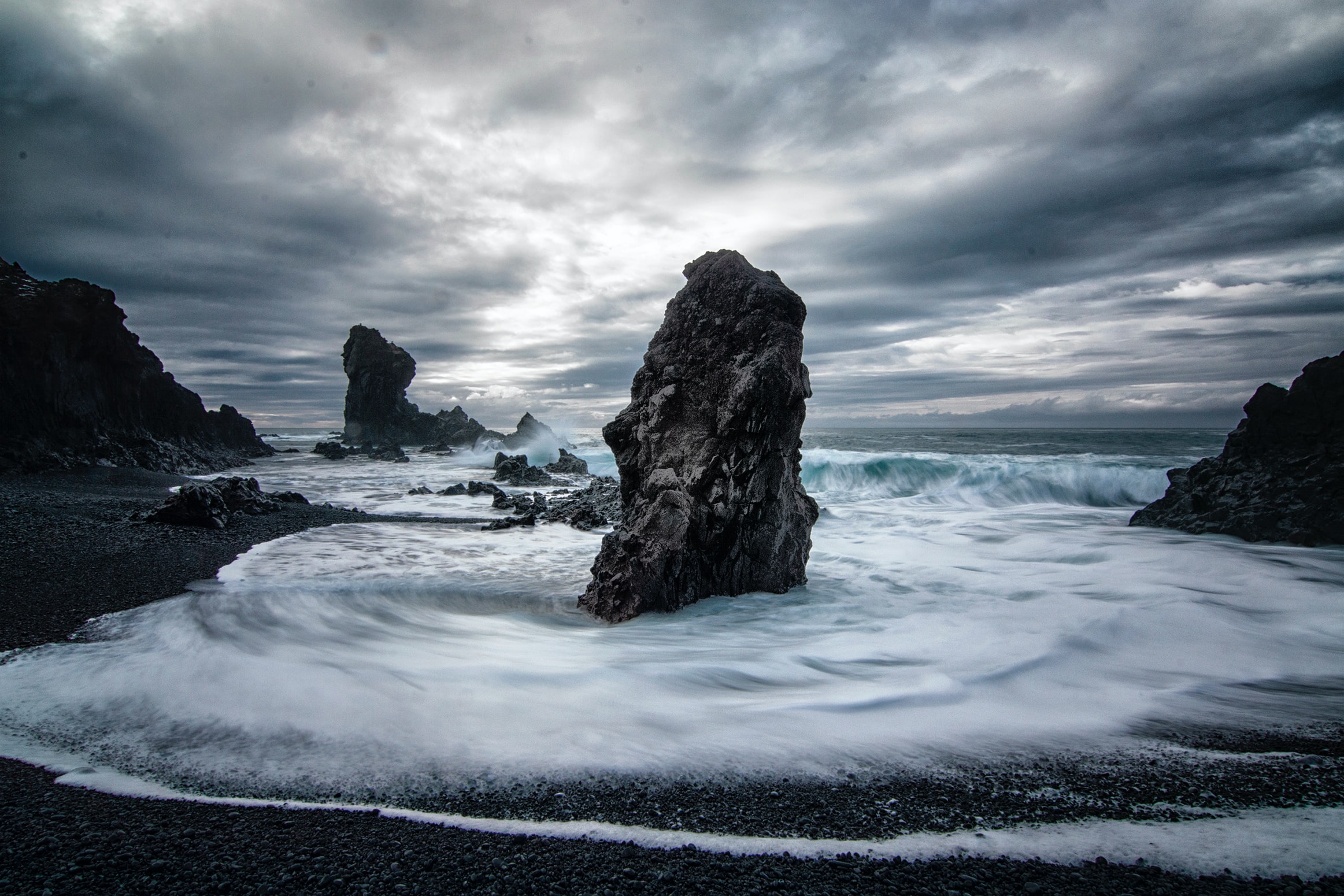
4. Djúpalónssandur at the edge of the world
If you find yourself in Snæfellsnes at the foot of another famous glacier, you must certainly make a stop at Djúpalónssandur. This is a place of many curiosities and treasures in black sand beach Iceland, so tread carefully here.
Located at the edge of the Snæfellsnes peninsula, you’ll find that the sand is hidden under a layer of polished black pebbled. These are Djúpalónsperlur, or the “Pearls of Djúpalón”.
They are protected, and so are the twisted pieces of metal that rest on top of them. These are pieces of the British trawler the Epine GY7, and they rest on this beach in memory of the men that lost their lives in a blizzard there.
This is only one of many stories on this beach, as it used to be an epicenter of activity when fishing was a smaller industry in the hands of the people.
Nearly all of the rock formations, springs, and sea stacks have names and stories, and tales of being elven structures or frozen trolls who saw the daylight. You could spend weeks in these coves learning the history of each mark in the land.
If you’re a history buff or a story lover in black sand beach Iceland, make sure to grab some literature about this area, and leave nothing but footprints in the sand behind you. This is a hallowed place of memories gone by, and a protected zone.
Not to mention, a remote area with similar wave patterns to Reynisfjara. Enjoy the aurora from a safe distance, and be respectful of the different souls that may be watching with you.
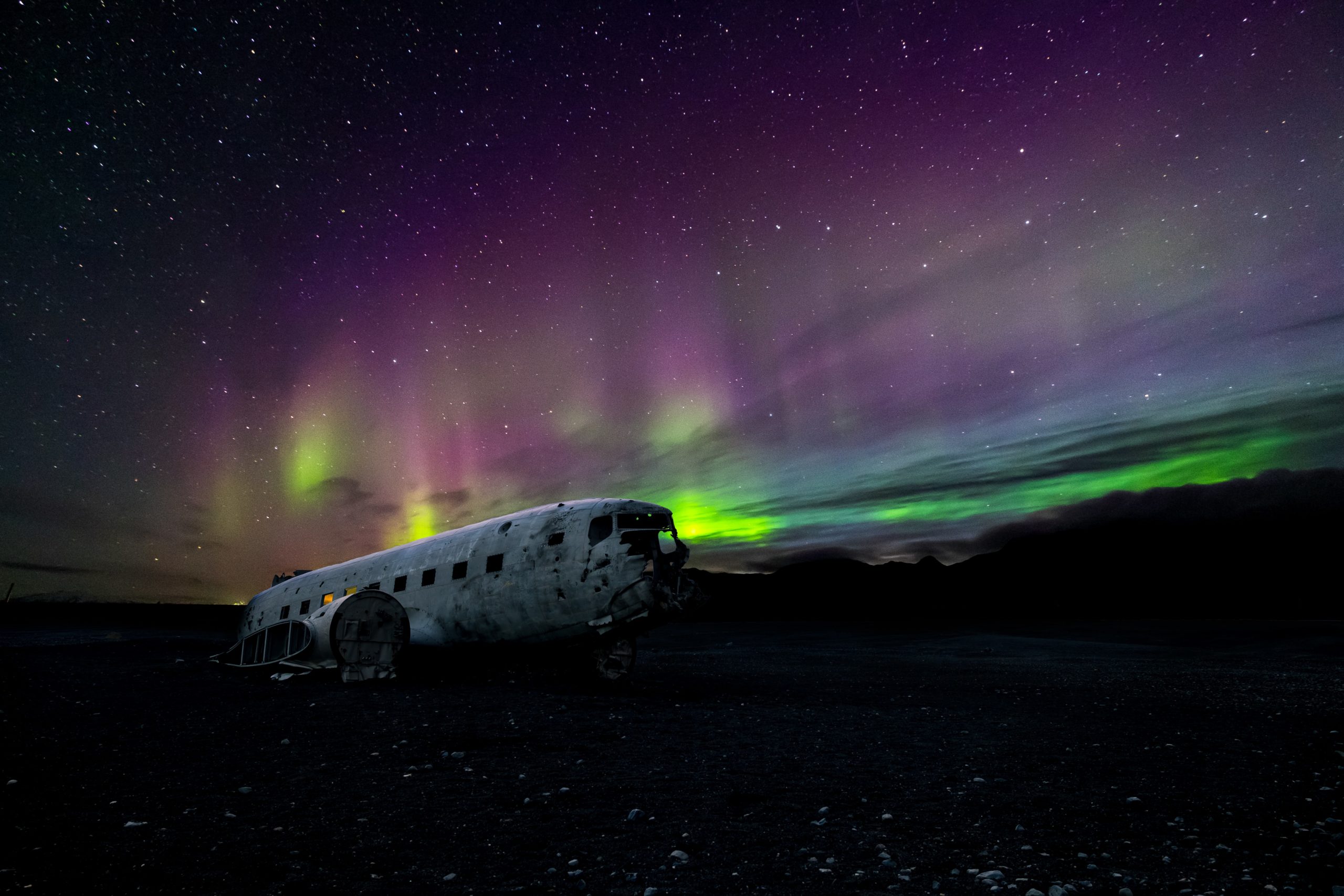
5. Solheimasandur and the plane wreck
There are a lot of beaches in black sand beach Iceland, but this is a special one. A smaller part of the big stretch of the long southern coast, Solheimasandur is another creation of volcanic eruptions creating glacial outburst floods, and the sand flats of this area are vast.
Because of its volcanic history, Solheimasandur is not home to any villages or large settlements. It is, however, home to the US Navy DC-3 plane wreck, a landmark sought by photographers and curiosity seekers alike.
In 1973 due to a fueling problem, this plane crash-landed here on the sand. All parties involved survived, and walked away from this impromptu landing in one piece, so it is not truly a memorial piece.
Getting to the wreck takes a bit of a walk, but it’s worth it to gaze upon this strange visitor among the sands. This is a truly desolate place, so take caution if you are visiting here in the nighttime or the winter season.
It is good to check ahead on the weather, as the sand wastes are disorienting and visitors in the past have gotten lost here. With little to nowhere to hide, it is possible to risk exposure and it is unlikely that you will come across much help.
Though this is a popular northern light photo opportunity, look out for your safety first. Those airmen walked away from this wreck, and in order to enjoy more of black sand beach Iceland, so must you.
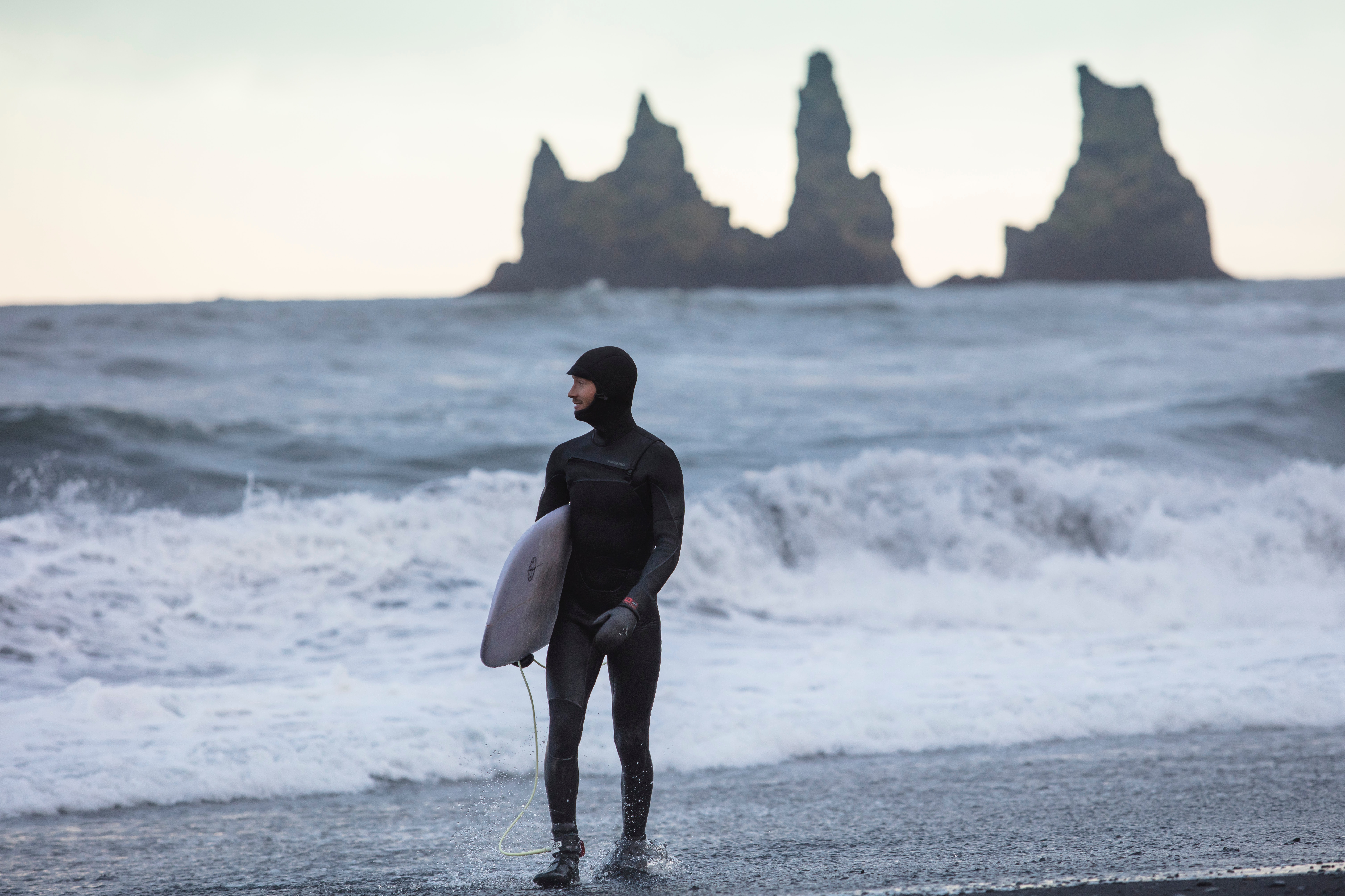
6. Catch a wave on Thorli Beach
The Reykjanes peninsula is known for its big, consistent waves, and believe it or not, is a long time favorite of arctic surfers. Thorli is a fairly advanced spot near the town of Þorlákshöfn (Thorlákshöfn) and it sports an unusual mix of both black and yellow sands.
Beloved by local and visiting surfers, Thorli is a long crescent of sand at the heart of Iceland’s surfing community. And though there are different waves to catch throughout the year, the high point for big surf is right smack in the middle of aurora season.
If you’re a seasoned surfer, this is the beach for you. (And if you’re an aurora hunter- the best of both worlds!)
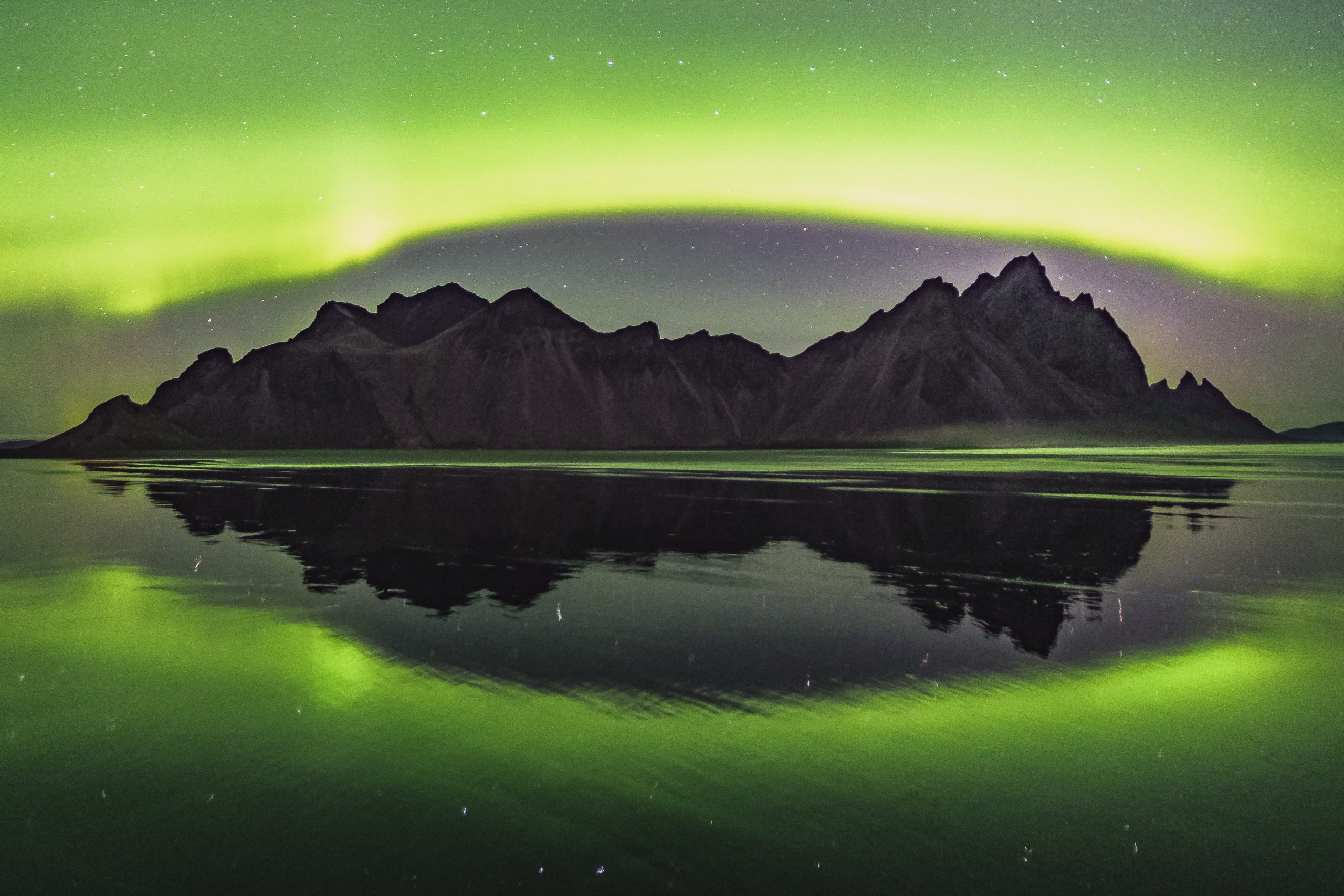
7. Stokksnes the Mirror Beach
Stokksnes is a photographer’s dream. At the eastern edge of Iceland lies the long flat shore of Stokksnes, and the jagged dragon’s-teeth peaks of Vestrahorn. Close to the town of Höfn, this area either welcomes you back to the sand deserts of the south or announces your arrival to the dramatic mountains of the east.
But before you go further either way, you should take a moment to stop at Stokksnes. This beach is wide and flat, which causes the tide to leave water behind as it recedes. This creates a shallow and incredibly reflective surface, allowing incredible reflection pictures of the mountain Vestrahorn, the surreal black dunes, and potentially, the colorful, dancing aurora.
There is a small fee to visit the beach, as it is privately owned land- but it is more than worth it to help preserve the majesty of this place.
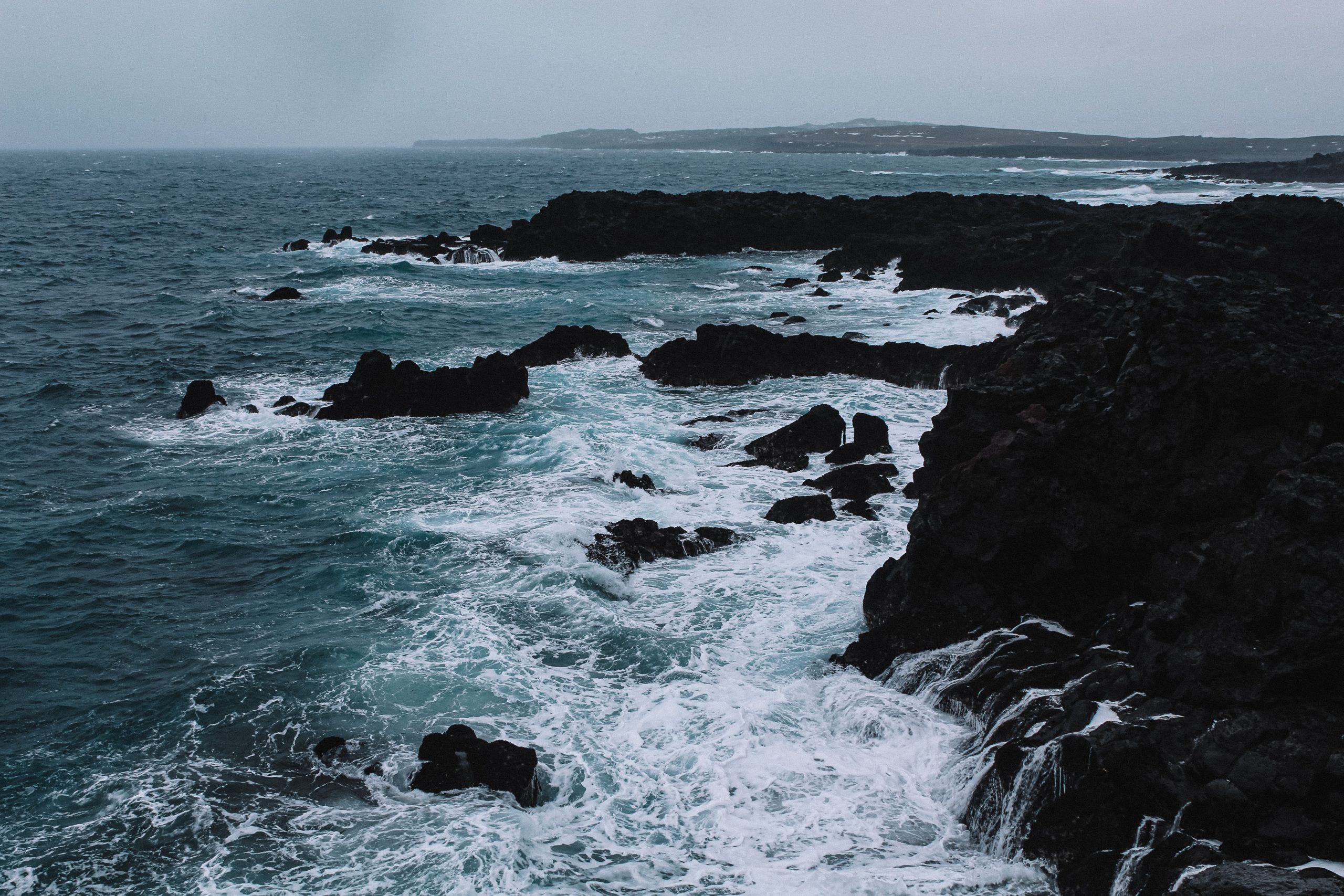
8. Everybody’s gone surfin’...In Sandvík and Grindavík
For those who aren’t ready to catch a big Thorli wave, there is the slightly more forgiving beach break of Sandvík, where many locals catch their first waves. Most of Iceland’s surfing beaches are reef or point breaks, which means you’ll be dodging a lot of sharp volcanic rocks, and maybe some sea urchins.
For those who are only here to watch auroras, you are in great company. The peninsula of Reykjanes boasts long coasts of lonely beaches, and many friendly seaside towns to pick up snacks in.
(Including Grindavík, one of Iceland’s happiest towns! And the nearby neighbor of our recent fissure volcano, Fagradalsfjall.) In black sand beach Iceland, you can’t go wrong with cruising quiet Reykjanes.
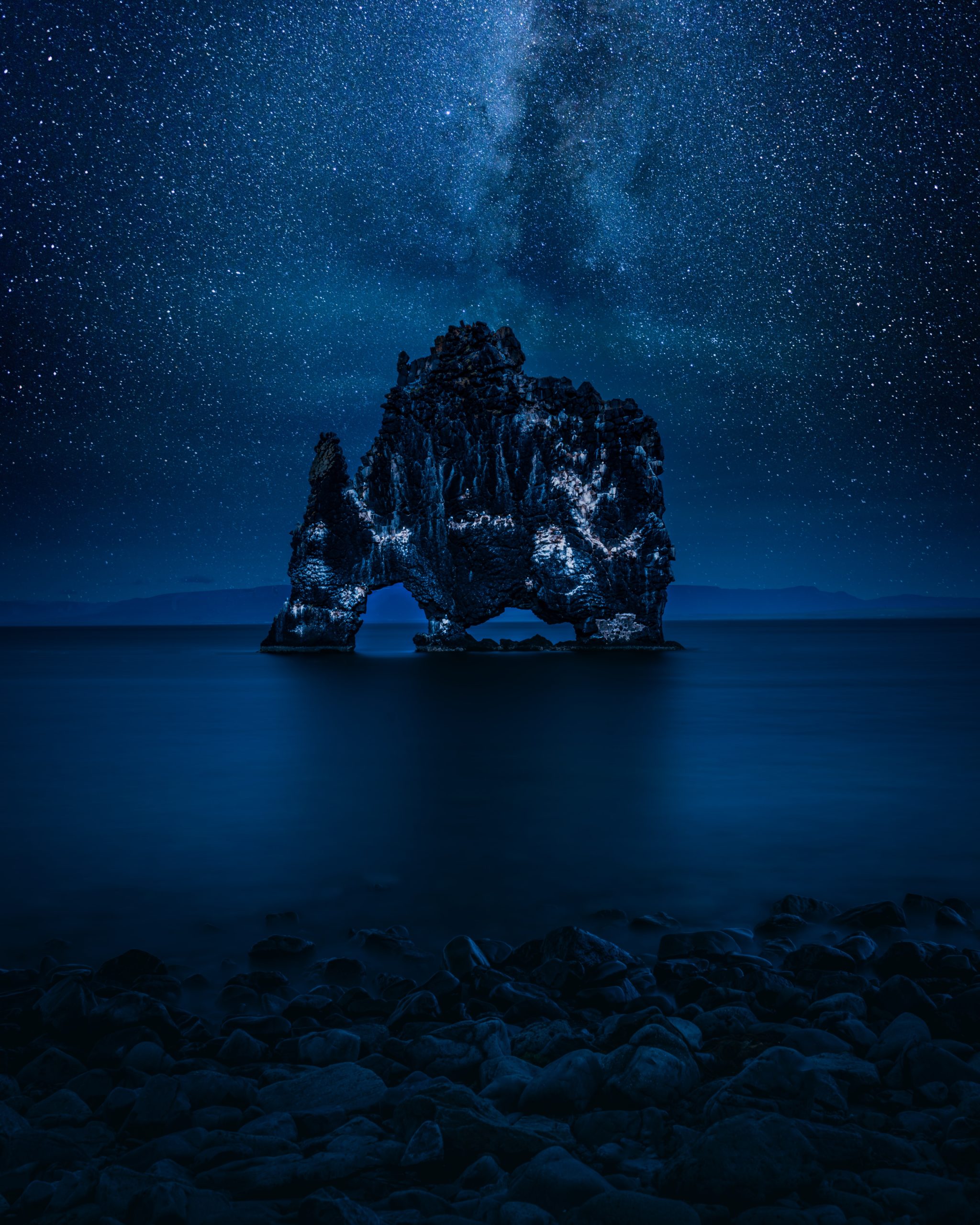
9. The Seal Circle at Vatnsnes
You’ve heard of the Golden Circle, and even the Diamond Circle- but what about the Seal Circle? The 711 road around the peninsula of Vatnsnes is a great spot for black sand, seals, and auroras. If you’re lucky, you can spot harbour seals, grey seals, harp seals, bearded seals, hooded seals, ringed seals, and maybe even a rare walrus or two!
The Illugastaðir beaches on the western side of the peninsula have been a notable home for them for many years, but these creatures can be spied year round throughout the peninsula. It is even possible to see them on the eastern side basking near famous Hvítserkur, a popular aurora photo spot.
You can stop in Hvammstangi to visit the Icelandic Seal Center to learn more about these curious residents, but don’t forget to keep your eyes on the sky. This is a popular aurora spot with low light pollution and many beloved foreground landmarks for great aurora shots.
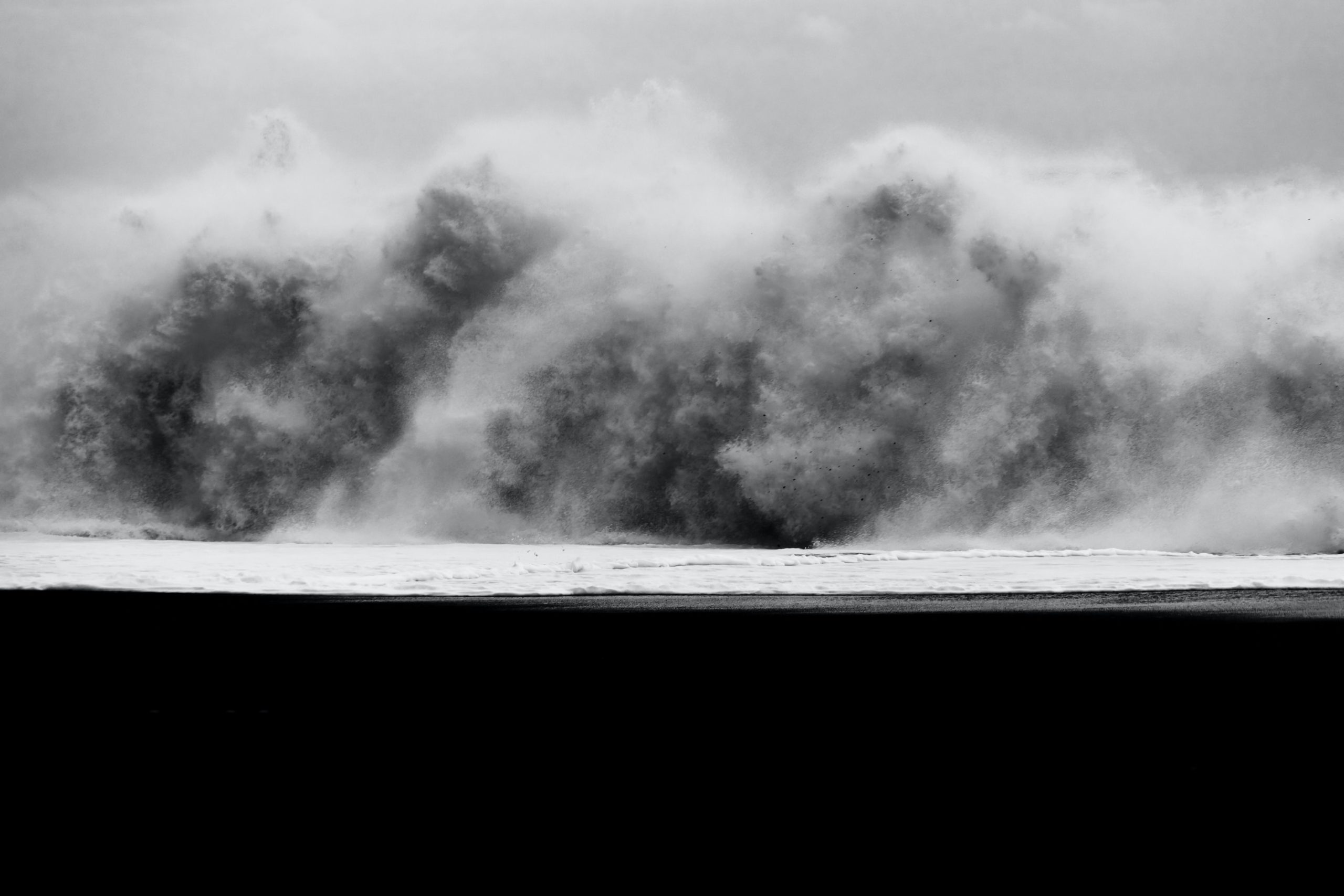
10. Ólafsfjörður on the Arctic Coast Way
North Iceland is a magical place punctuated by a more extreme climate, big mountains, and beautiful small towns throughout the fjords. There is a lot of history and tradition here, and even though it’s not by much- you are that much closer to the pole when you visit.
Ólafsfjörður is located in between the shark fishing village of Siglufjörður in the north, and Dalvík just below- home to world class skiing and “The Great Fish Day” festival (Fiskidagurinn mikli). This is another great peninsula to explore, and you guessed it, every single one of these towns boasts its own piece of black sand beach Iceland.
These are long, picturesque coastlines framed in by tall mountains and sweeping fjord views out to sea. They have long histories and unique cultures, even from village to village. And just like their skiing, when it comes to auroras- they are unparalleled.
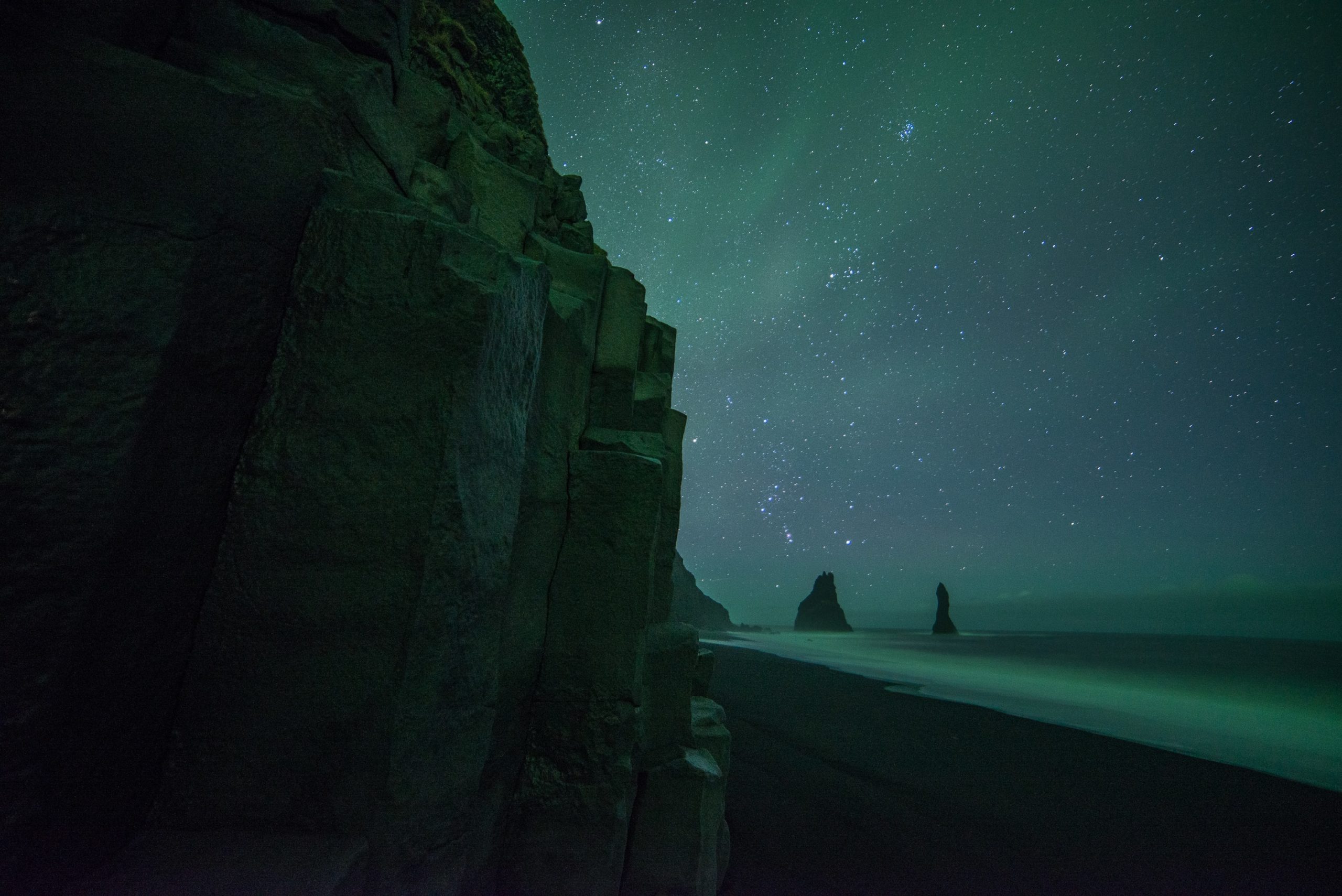
Aurora Hunter Top 10: Where is the best place to see the Northern Lights on the South Coast?
When the sky is only clear in one region, that’s where you’re headed! But once you get there, then what?
So you’re headed down south, and you want to know: “Where is the best place to see the northern lights on the South Coast?” So we’ve put our heads together and gathered up a few of our favorite spots along Iceland’s southern coast for aurora hunting. From the rare to the luxe, we’ve got one in here for everyone.
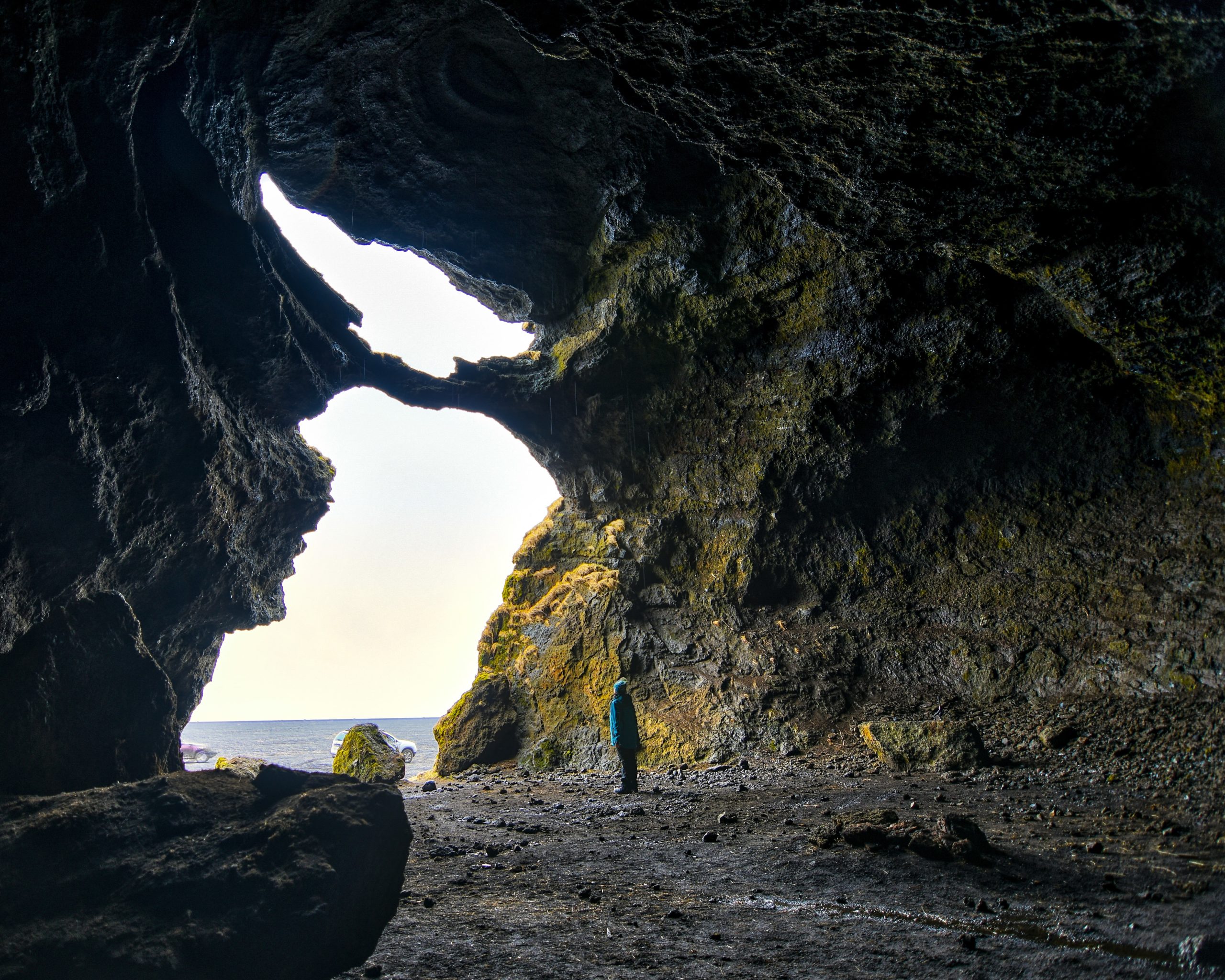
1. Gígjagjá at Hjörleifshöfði: The Yoda Cave
The south coast of Iceland is a dramatic landscape, no matter what season you visit. But if you’re looking for a spot a bit off of the beaten path to aurora watch from, look no further than the “Yoda Cave”.
The cave’s real name is Gígjagjá, but it is fondly known as “The Yoda Cave” since the entry to the shallow cave resembles a particular green individual. It is located in Hjörleifshöfði, which is an inselberg on the Mýrdalssandur plain near Vík.
Surrounded on all sides by vast black sand and seagrass flats, it is said that Hjörleifshöfði used to be an island, and the resting place of old Hjörleif himself. These days, you can drive up to it and enjoy multiple trails in its vicinity.
When inside the cave, you’ll find that the light from the outside illuminates the entry, creating a curiously familiar silhouette. Because of its shape, the cave entry is an amazing sight no matter when you visit. But imagine that shape filled with the majesty of dark sky, a million stars, and the dancing northern lights.. Not a bad spot.
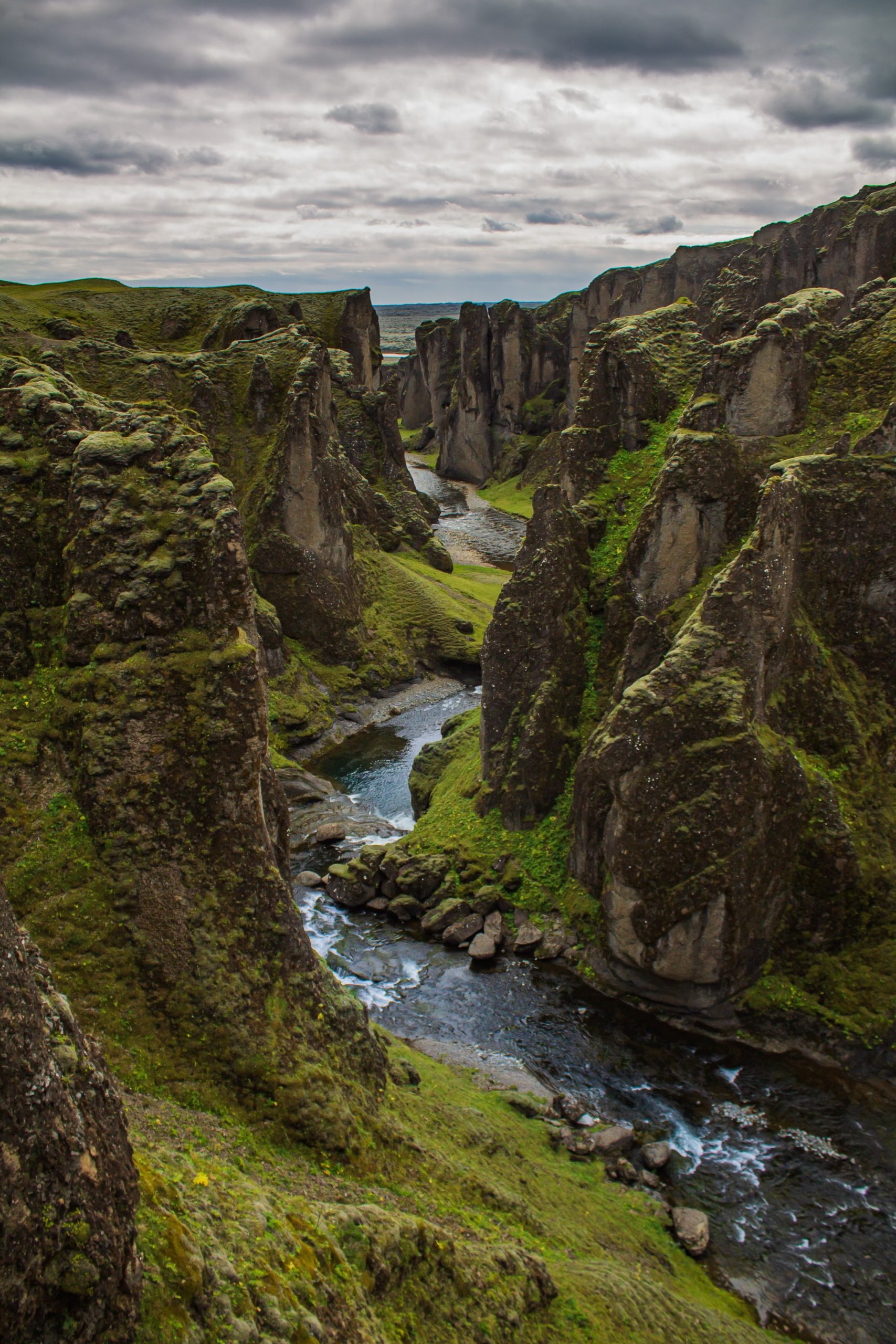
2. Fjaðrárgljúfur
At the more eastern edge of Iceland’s south coast, lies this ethereal canyon. Unlike many popular canyons, this one is not far from the main road. Right off of the village Kirkjubæjarklaustur, this canyon is nearly 2 km. long and houses the Fjaðrá river.
In good weather, the road to the canyon is accessible by all types of vehicles, and the hike along the canyon trail is easy and dry! This is key for those of us who are here to aurora hunt because unless you’re staying in Kirkjubæjarklaustur, you are probably not near a change of clothes.
The bottom of the canyon is home to an active river and a few waterfalls, not to mention protected vegetation and wildlife. Plus, the best view is on top. Fjaðrárgljúfur is a landscape photographer’s dream, so make sure you’re in the right place when the show starts!
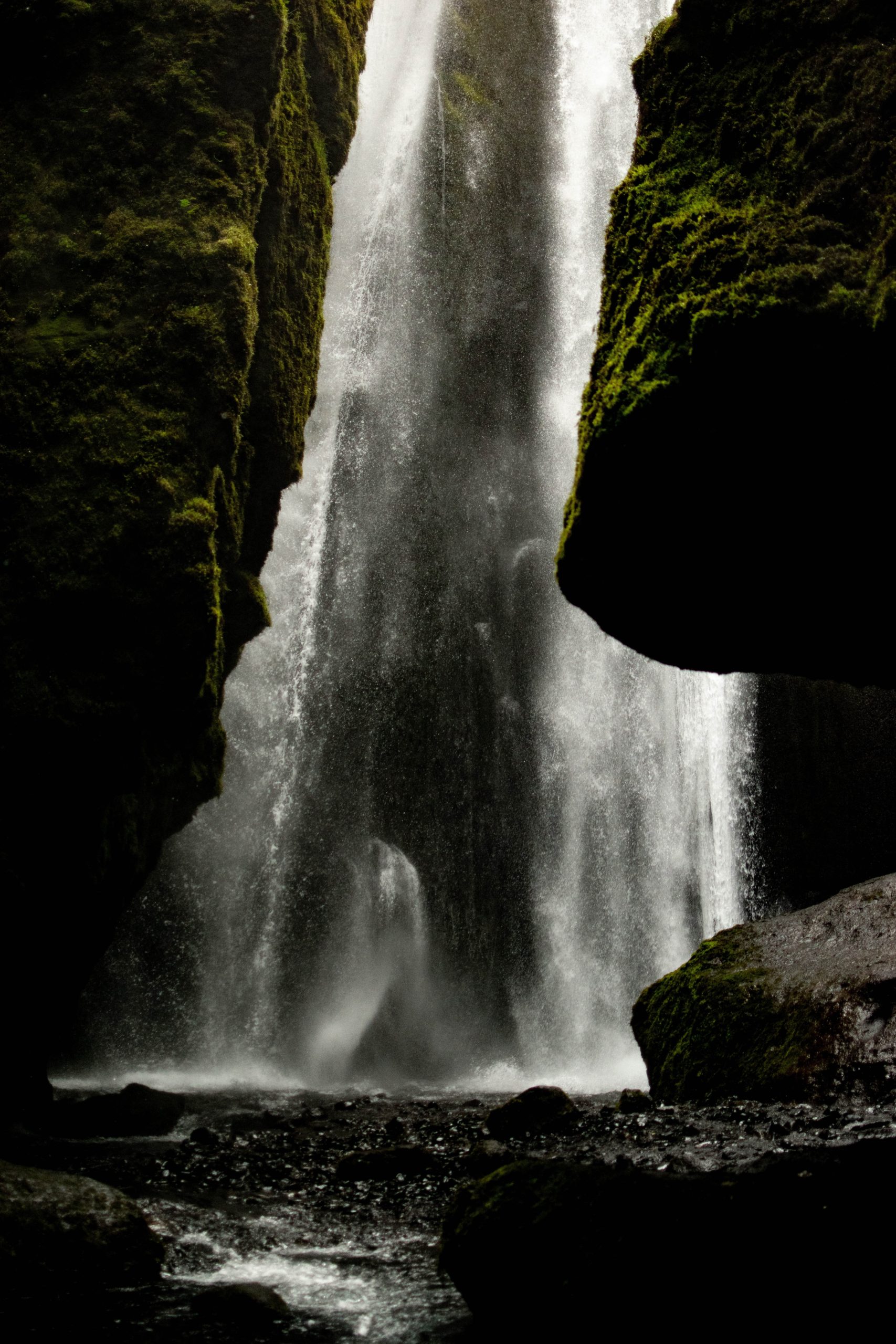
3. Gljúfrabúi & Seljalandsfoss
You probably already know Seljalandsfoss, but do you know its neighbor Gljúfrabúi? After walking behind the towering falls of Seljalandsfoss- an incredible spot in its own right – there’s a little known secret just a stone’s throw away.
Hidden in the same massive rock shelf that feeds Seljalandsfoss, this little waterfall is a hidden treasure of the south coast. When you approach, you see the stream of water first. Further down, you can see the falls peeking through the walls of the canyon. To access them up close, one must walk down the stream through the “halls” of rock.
Depending on the time of year and the conditions at the time of your visit, you may get wet! But once you make your way through the tiny canyon, you empty out into a natural room in the rock, where you can see the waterfall up close, and the sky up above.
Imagine seeing the aurora here, in Gljúfrabúi’s hidden chamber, with the mist of its spray all around. What’s the best place to see the Northern Lights on the South Coast? This is definitely one of them!
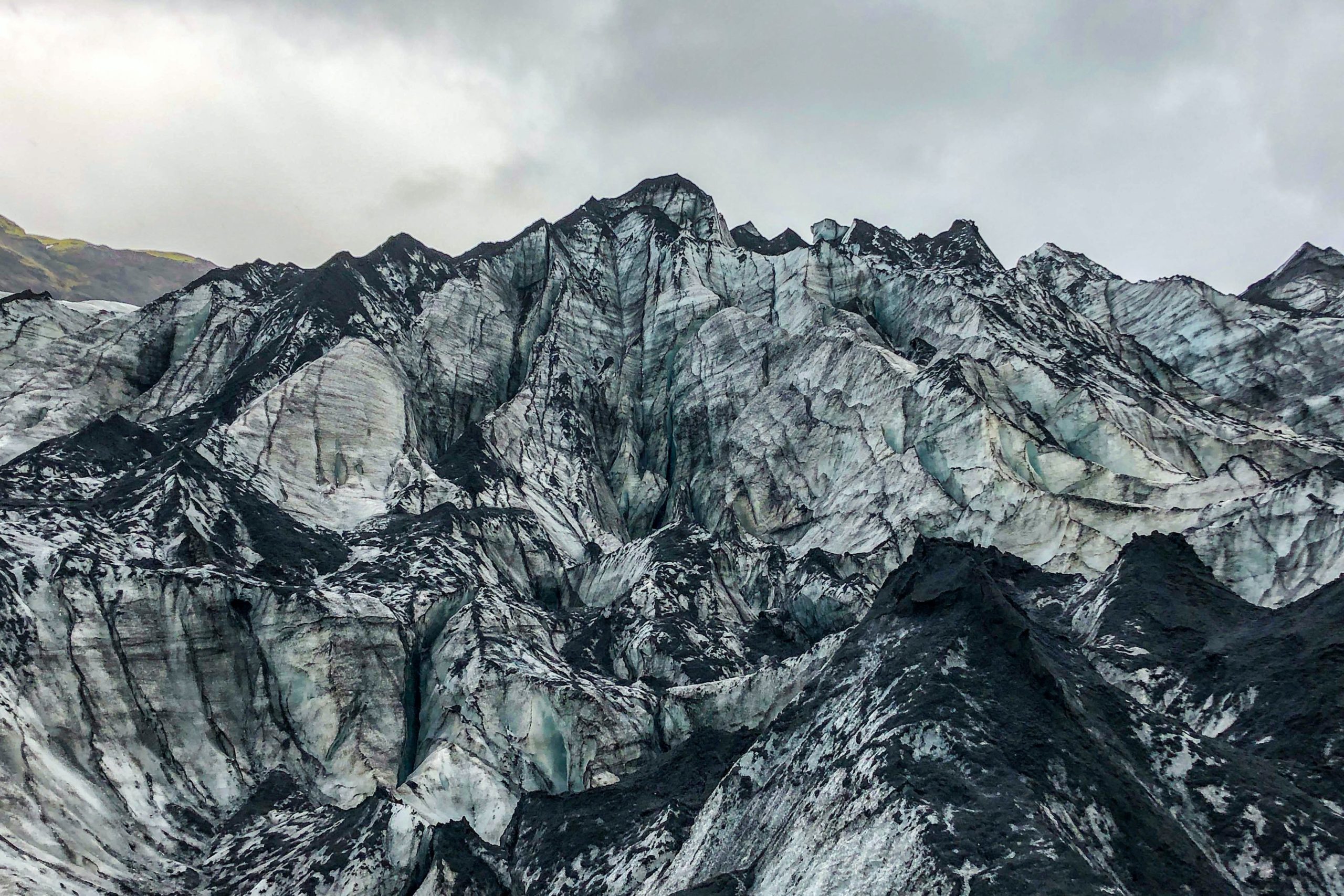
4. Sólheimajökull
Sólheimajökull is a piece of the larger Mýrdalsjökull, the south coast’s resident ice cap. (Mýrdalsjökull isn’t alone out here though, it shares the south with Vatnajökull, a glacier so big that it reaches through multiple regions!) This piece of the glacier is a popular location for glacier walking, ice caving, hiking, and just general wonderment.
This ice giant is incredible to see up close, and it is changing by the minute. One can visit the glacier on their own, but due to the extra training that it takes to traverse ice, it is only recommended to climb on with a guide.
Because of how quickly they are receding, one can’t make enough trips out to see the glaciers. They are visible reminders of how many gifts nature has bestowed upon us. …And seeing the lights in their presence is just one more gift on the neverending pile.
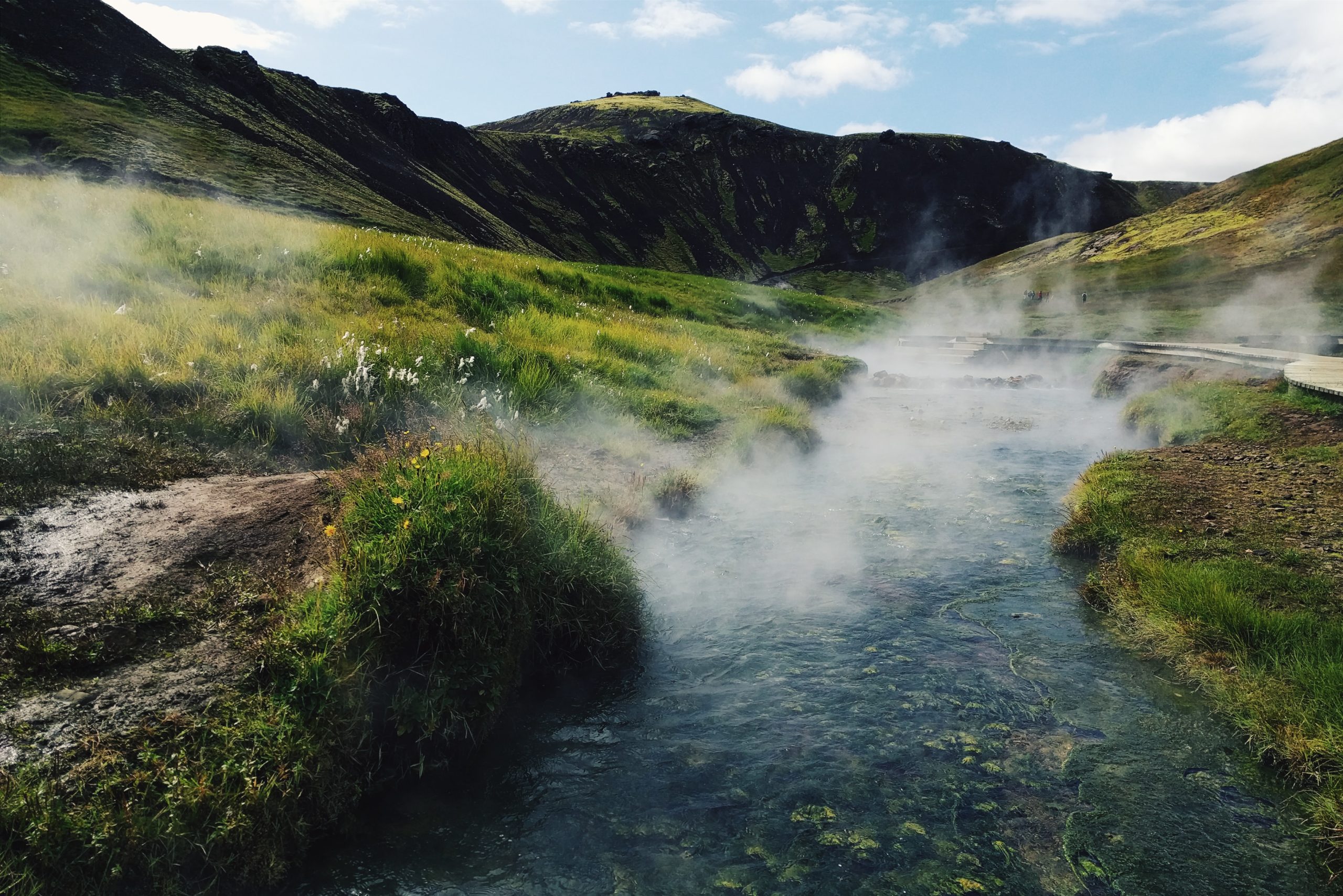
5. Reykjadalur
Reykjadalur is nearly 30 minutes from Reykjavik, so in some ways, it’s like the gateway to the south coast. Resting in the mountains above Hveragerði, Reykjadalur is a favorite of locals for its beauty, its accessibility, and its naturally hot water.
Reykjadalur means “Valley of Steam”, and it houses a geothermally heated river. This is a colorful area full of steam, bubbling mud, and incredible views as you ascend into these seemingly living mountains. It’s also mostly undeveloped!
There are maintained trails and even some protective boardwalk in the area around the water, but at this time there is no entrance fee, no buildings, and no facilities in this area. This could change over time, but for now, Reykjadalur is a place that belongs only to nature. The hike up takes around 45 minutes to an hour, and once you’re up there it is beyond heavenly to peel off your hiking gear and just lay in the warm river.
It is an incredibly restorative experience. Be careful, though! There are different temperatures throughout the water, so the further down the river you go, the hotter the water gets. This is mountain territory, so while the hike is not considered difficult, winter conditions can add some challenge to the terrain- even for the most seasoned hiker.
Things like early darkness, low clouds, and ice can make this an intense trek, so don’t forget your spikes and torches. But if you do make it up here, laying back in the hot water with your eye on the dancing sky- we’ll leave it to you to answer “Where is the best place to see the northern lights on the south coast?” I think we know what you’ll say.
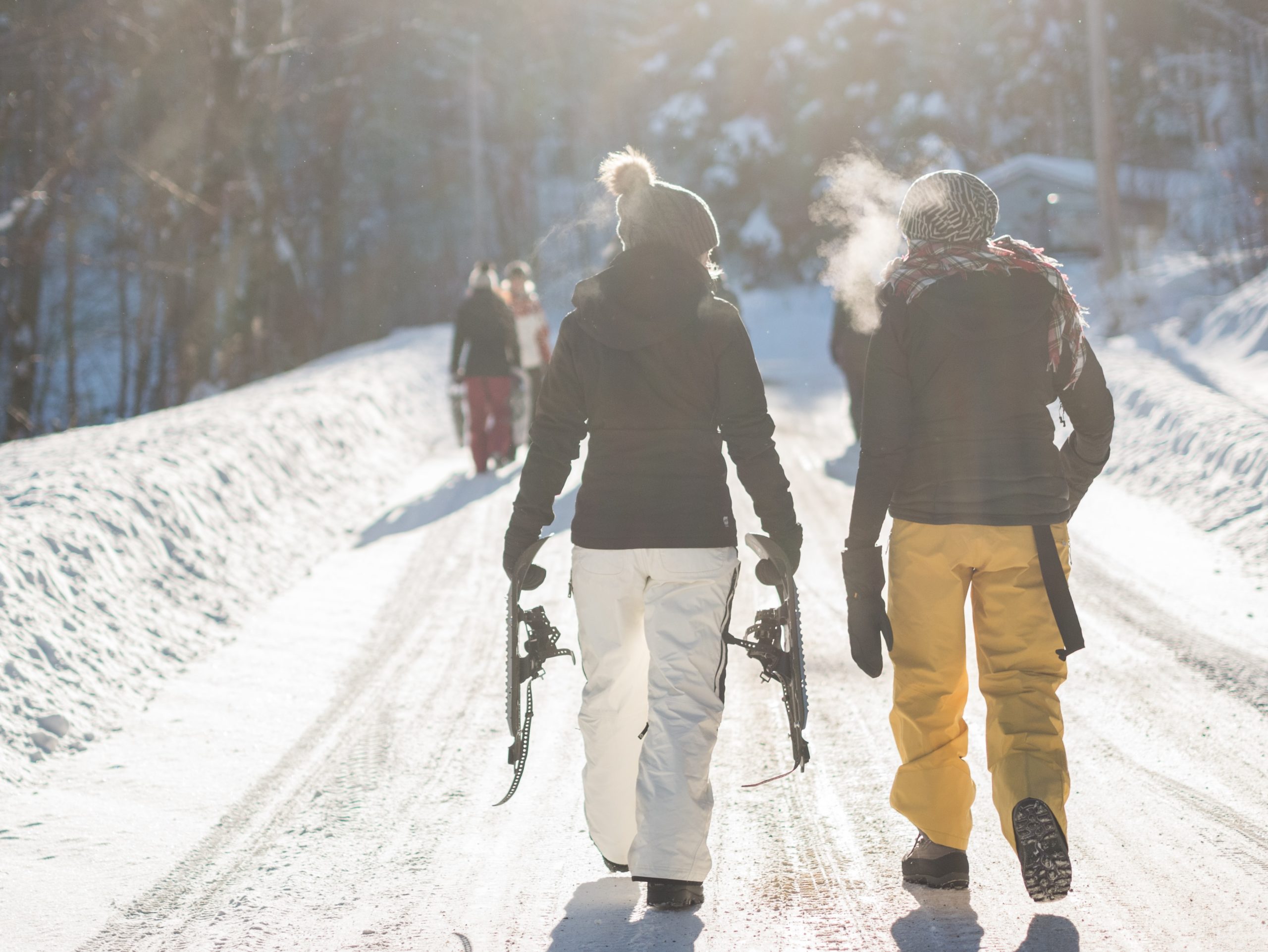
6. Bláfjöll
Even though we just crowned Reykjadalur as the gateway to the south coast- some could argue that that title truly belongs to Bláfjöll. Known as the “blue mountains”, Bláfjöll is a small mountain range that lies about 30 km from Reykjavik, just before Hveragerði.
Though popular for hiking, caving, and lava tubing pursuits- this area shares its name with the ski slopes that live amongst them. Driving through this area is one of your first tastes of wild country outside the capital, and it provides many quiet spots for aurora watching off the main road.
If you visit before the snow, you may get to experience a different type of lush covering- Bláfjöll’s endless fields of Icelandic moss. This moss covers the lava fields and huge swaths of the mountains themselves and can be seen for miles around.
Insulated by the snow in the height of winter, it returns to us every year despite its fragility. The moss takes ages to regrow after damage, so be careful not to walk upon it when hiking.

7. The plane wreck at Sólheimasandur
One of the more unusual stops, this is a pretty interesting one. Though it sounds grim, this plane wreck was non-fatal, and all of the passengers escaped unharmed. In 1973, a US Navy DC plane appeared to run out of fuel and had to crash land on Sólheimasandur– a vast black sand beach on the south coast.
The people inside made it out, but they left their airplane behind. The wreck of this plane is still resting on the beach today, a bit worn and smoothed by the endless Icelandic wind and the movement of the volcanic sand. It is a favorite location of photographers, and many have watched the lights from its empty belly.
If you choose to visit this spot, please exercise caution. While it is a flat land hike, it does take around an hour of treading sand to reach the wreck, and it cannot be seen from the road. You can leave your vehicle in the parking area, but you can no longer drive up to the location. This area is vast, and it is not populated by many landmarks- so it is easy to get disoriented here.
Be aware of the weather before you head out, as there have been accidents of exposure and hypothermia in the past. It is possible to visit the location with a guide, but be respectful of the area nonetheless. Just like the moss, we wish to preserve the unique strangeness of the wreck for years to come- so that many can spy the aurora from its wings.
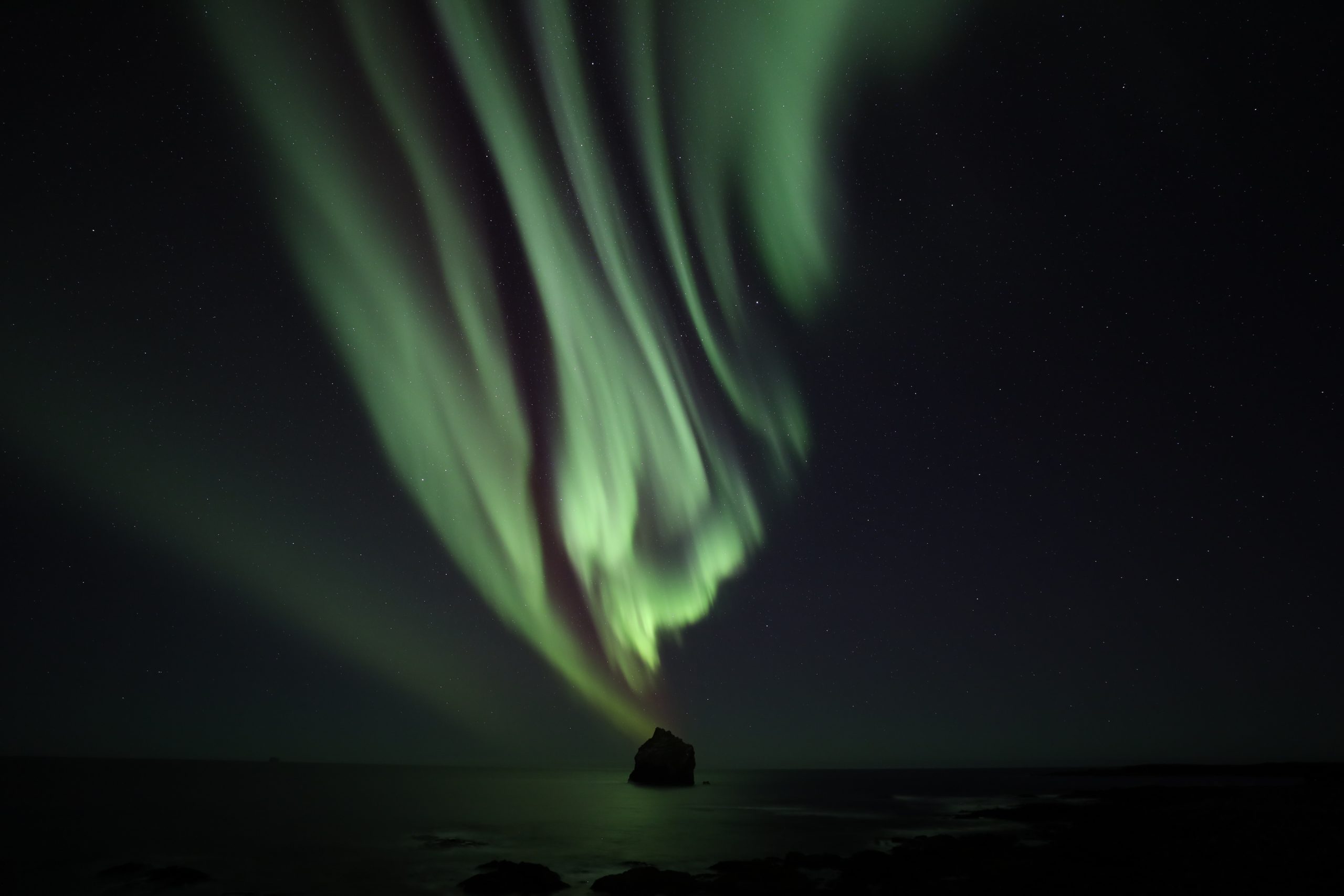
8. Þorlákshöfn (Thorlakshofn)
Wedged right in the corner of the coast where the Reykjanes peninsula meets with the full curve of the island, lies the little town of Þorlákshöfn. Known around the country as one of the primary places to catch a ferry to the Westman Isles– this is a charming seaside town.
Right along the edge of the coast, there are gorgeous villages to explore, and this is only one of them. This town rests at the end of the Ölfusá river and counts many curiosities among its hiking trails, bustling port, and beautiful sights.
If you’re planning a night out of aurora watching by the sea, this is certainly a good place to stop for a bite first. (Or to ride ATVs, horses, do some rock climbing, check out some sea caves, and more!)
This is a beautiful community where you can appreciate the brevity of Icelandic living, and the relationship between the sea and the warm volcanic land in which that life continues to thrive.
When we asked “Where is the best place to see the northern lights?”, it was not hard to imagine this place. (But don’t end your adventure here! If the weather is mild, hop the ferry to the Westman Isles! Southern Iceland really is a whole world of its own.)
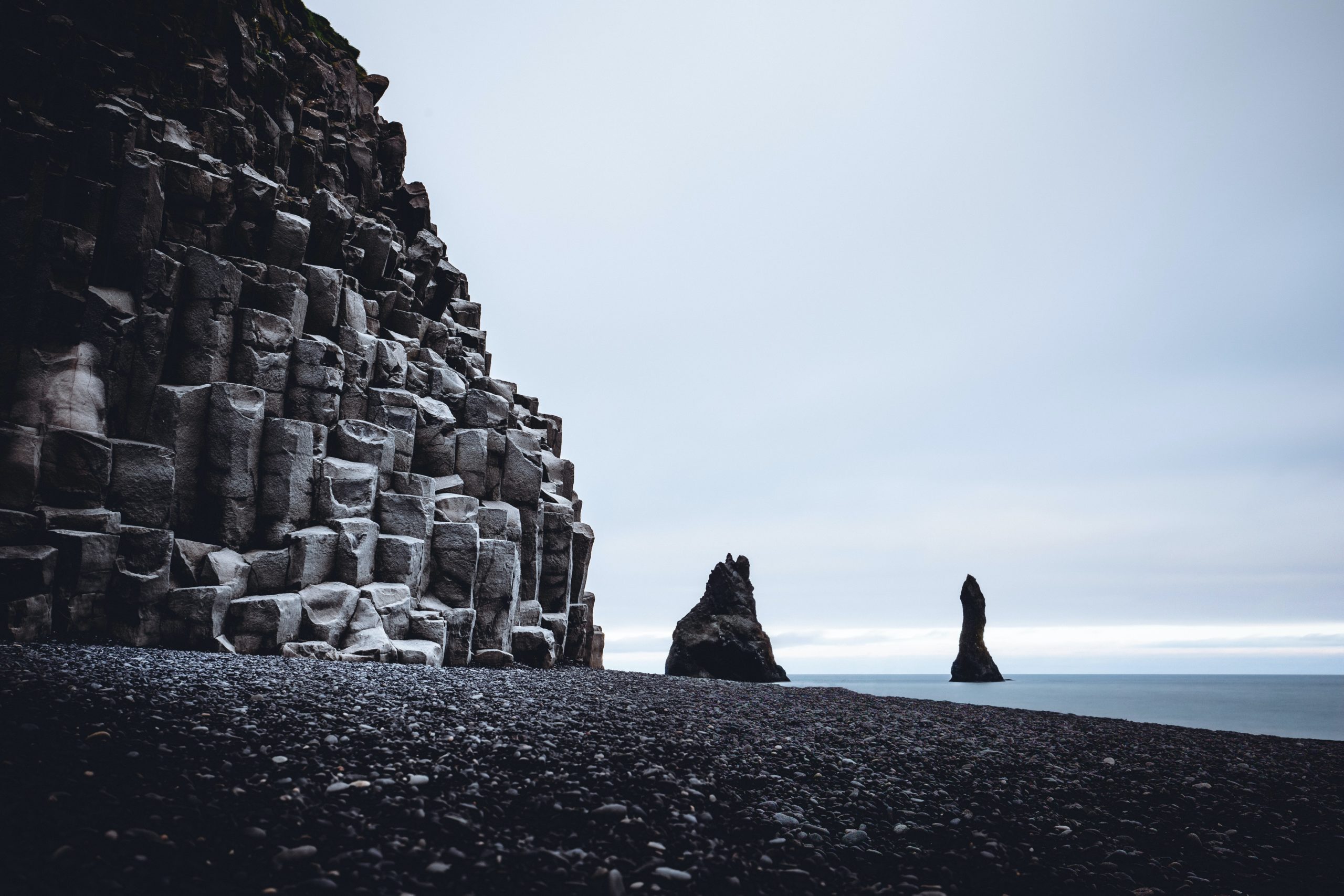
9. Reynisfjara
This is a popular spot, but it sure is hard to argue with. Reynisfjara is the name of the black sand beach near the village of Vík. Seen in countless films, tv productions, photographs, and artistic works- it’s a must see location.
Vík is the southernmost village on the island, and a great spot to branch out from if you plan on exploring the south coast region. Home to many activities, restaurants, and shops, this area is lined by dramatic basalt cliffs that thousands of seabirds call home in the summer season.
Though beautiful, the waves here can be massive and are known to be dangerous, so please exercise caution near the shoreline. Due to the small population of the town, you’ll find great dark skies here. We love Reynisfjara year round, but it truly is a magical place to watch the northern lights, in the shadow of slumbering Katla.
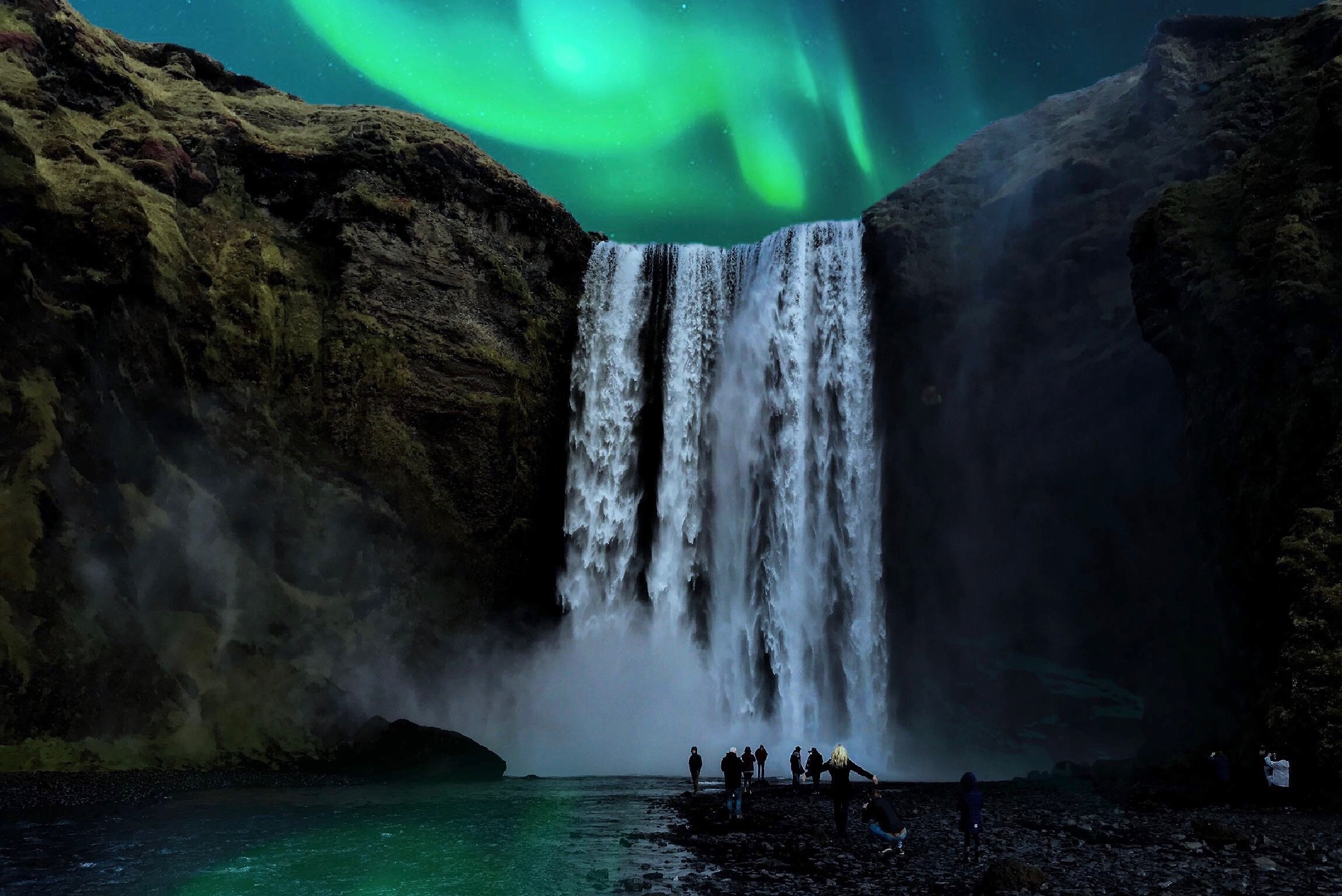
10. Skógafoss
Last but not least, we can’t leave this thundering giant off of a south coast adventure list. Not only is it close to some of our favorite northern lights hotels, but it makes an incredible aurora vantage point.
If you visit earlier in the day, you can climb to the top of the falls and enjoy the 25+ waterfall trek known as waterfall way! (You thought the show was just Skógafoss? Guess again!)
Skógafoss is the grand finale of the Fimmvörðuháls path, a 22 km. trek into the hiker’s paradise, Thórsmörk. While this adventure might not be possible in high winter, you can catch the tail end of its availability in autumn. For those that don’t wish to make the full 22 km., waterfall way is only about 8 km. one way, following the river.
But this is extra. Skógafoss itself is phenomenal. Standing at 60 m. high and 25 m. across, you can see this wonder right from the main road. It creates huge clouds of mist, and it empties out on a vast plane of land that runs out to the sea.
You could spend a whole day here exploring the surrounding area and enjoying the falls from different vantage points. You can even throw up a tent and camp out nearby, lulling yourself to sleep to the constant hum of falling water. Don’t forget to look up though! The rainbows in the mist during the day are hard to compare to the aurora curving over the cliff edge at night.
The best place to see Northern Lights in Iceland: 10 of the most magical spots for aurora watching and stargazing
No matter how many times we’ve seen the aurora, we’re always looking for the best place to see northern lights in Iceland.
We never stop looking for the best place to see northern lights in Iceland. From the far reaches of the west, to the lush forests of the east- it is impossible to count them all. Iceland may be a small island, but the hidden treasures here are many. Where was the best place you watched the sky from?
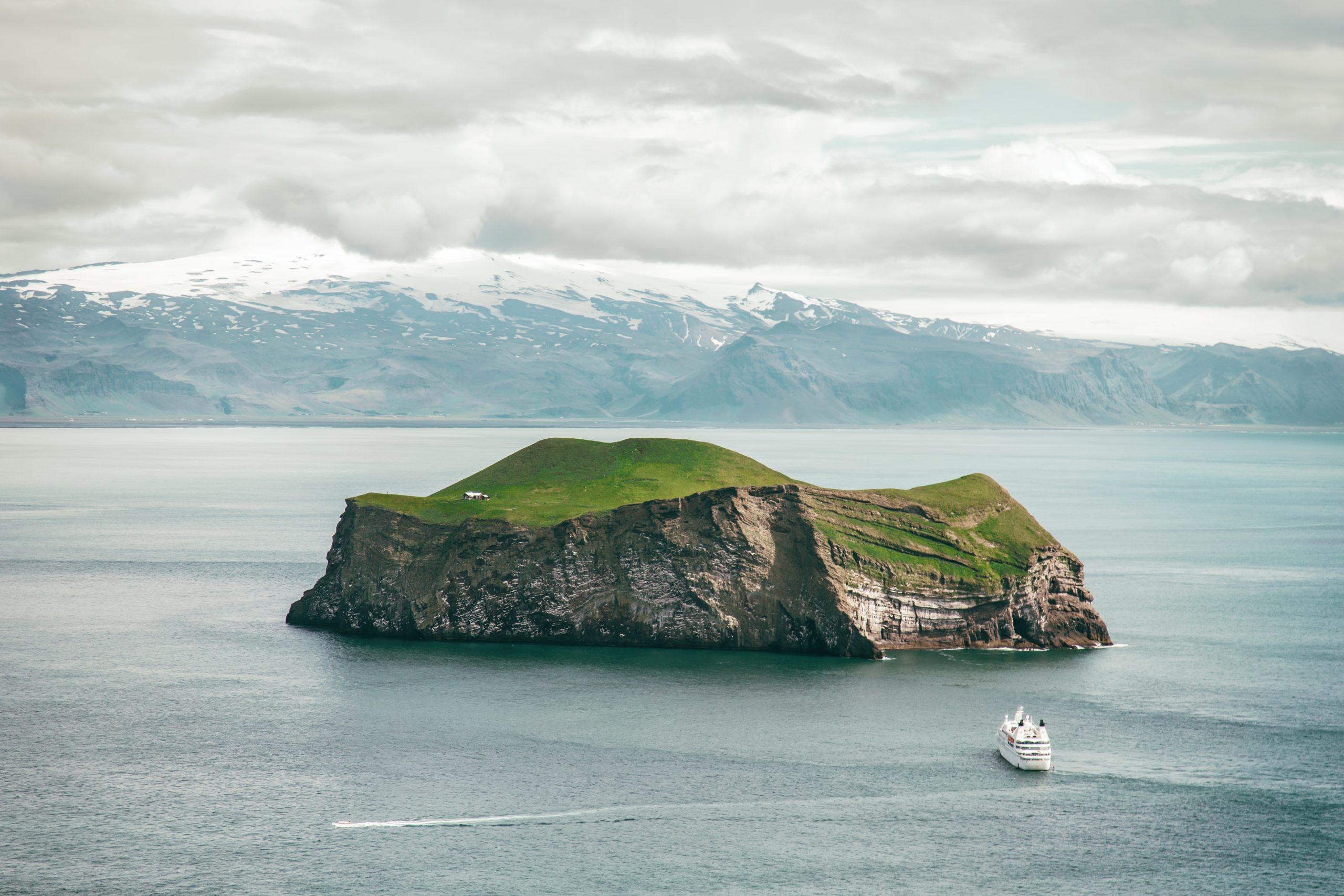
1. Vestmannaeyjar
Vestmannaeyjar, or The Westman Islands, lie right off of Iceland’s south coast. Accessible by ferry or plane, they are an often overlooked gem and in our opinion, a best place to see northern lights in Iceland.
The Westman Islands are a self-contained world all to themselves, and boast some of the warmest annual temperatures in the entire country! Benefitting from the gulf stream, they are known as a wildlife-rich area that enjoys plentiful fishing, whale and birdwatching, and music festivals and sport in the summer.
A visit to the Westman Isles is punctuated by incredible sights. Lighthouses on rock stacks, one of the most famous volcanic eruptions in modern history, vast sea caves, and a whole chain of gorgeous, uninhabited islands. And being far south, one of the last places to catch the lights at the end of the auroral season.
Many great country aurora spots are remote, but here in Vestmannaeyjar you’ve got everything you can think of within a few kilometers. Including some of Iceland’s most notable golfing and dining!
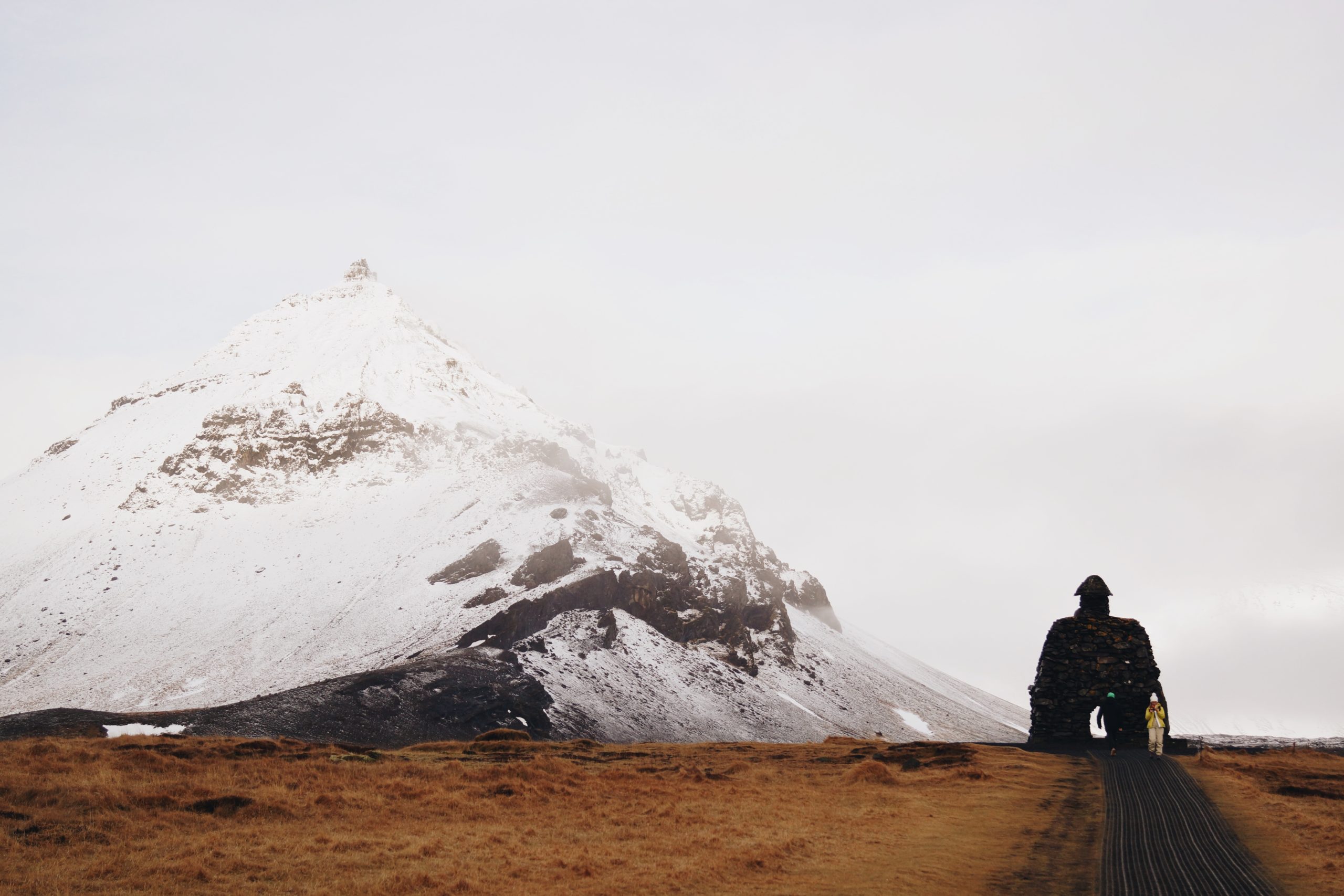
2. Hellnar in Snæfellsnes
The peninsula above Reykjavik is known as Snæfellsnes. A place that enchanted Jules Verne and featured in many historical Saga tales, Snæfellsnes became an EarthCheck community in 2008.
Truthfully you could travel the whole of the peninsula, and find thousands of good aurora spots. This is not a heavily populated zone, and during the day it is a phenomenal sightseeing location.
But we’re spilling the details on our favorite spots, so Hellnar has to make the cut! An ancient fishing village for many generations, Hellnar is perched on the tip of the peninsula overlooking the curved basalt coastline and the thundering sea.
People come from miles around to seal and whale watch, enjoy the varied geology of the area and view the countless natural landmarks in peace. You can travel quietly here, and enjoy the high-quality darkness of this northerly locale.
When in Hellnar, one can nearly imagine what it might have been like in centuries past- a bustling destination under a slumbering volcano.
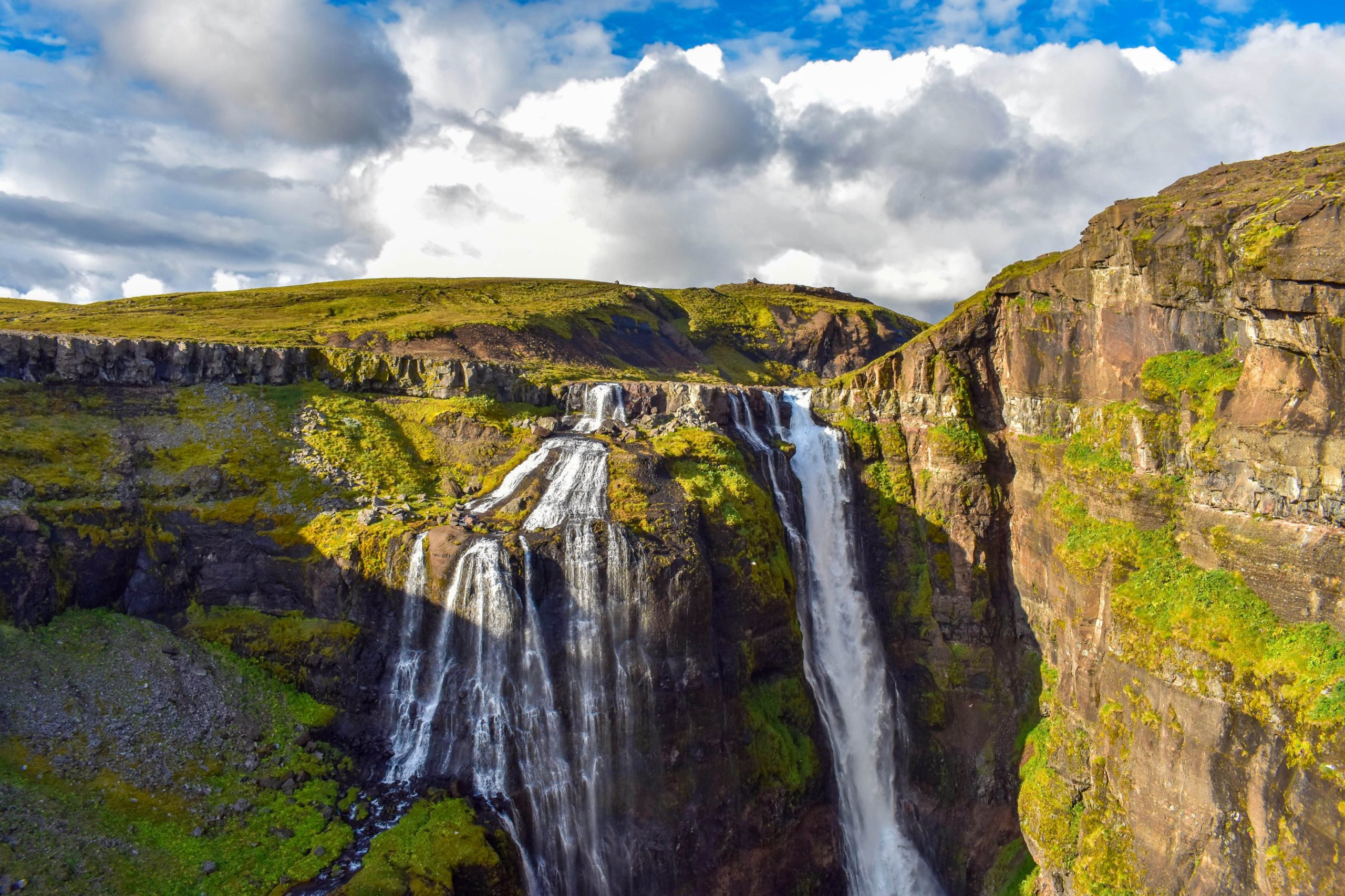
3. Hvalfjörður
Just outside of Reykjavik lies a hidden treasure off the main road. Hvalfjörður is the name of the fjord that lies between Mosfellsbær and Akranes. A short trip from the capital city, Hvalfjörður is home to many small waterfalls and hiking paths.
The popular trek to Glymur starts here, and many coastal hikes as well. The fjord itself is 30 kilometers long and there is not a stitch of it that does not house some kind of tiny wonder. Often passed over for more notable climes, this is a calm and beautiful place to aurora watch, with multiple marked observation points that are safe to park in.
Great for some daytime and evening hiking while you wait, the textured vistas and low traffic certainly make Hvalfjörður feel like the best place to see northern lights in Iceland.
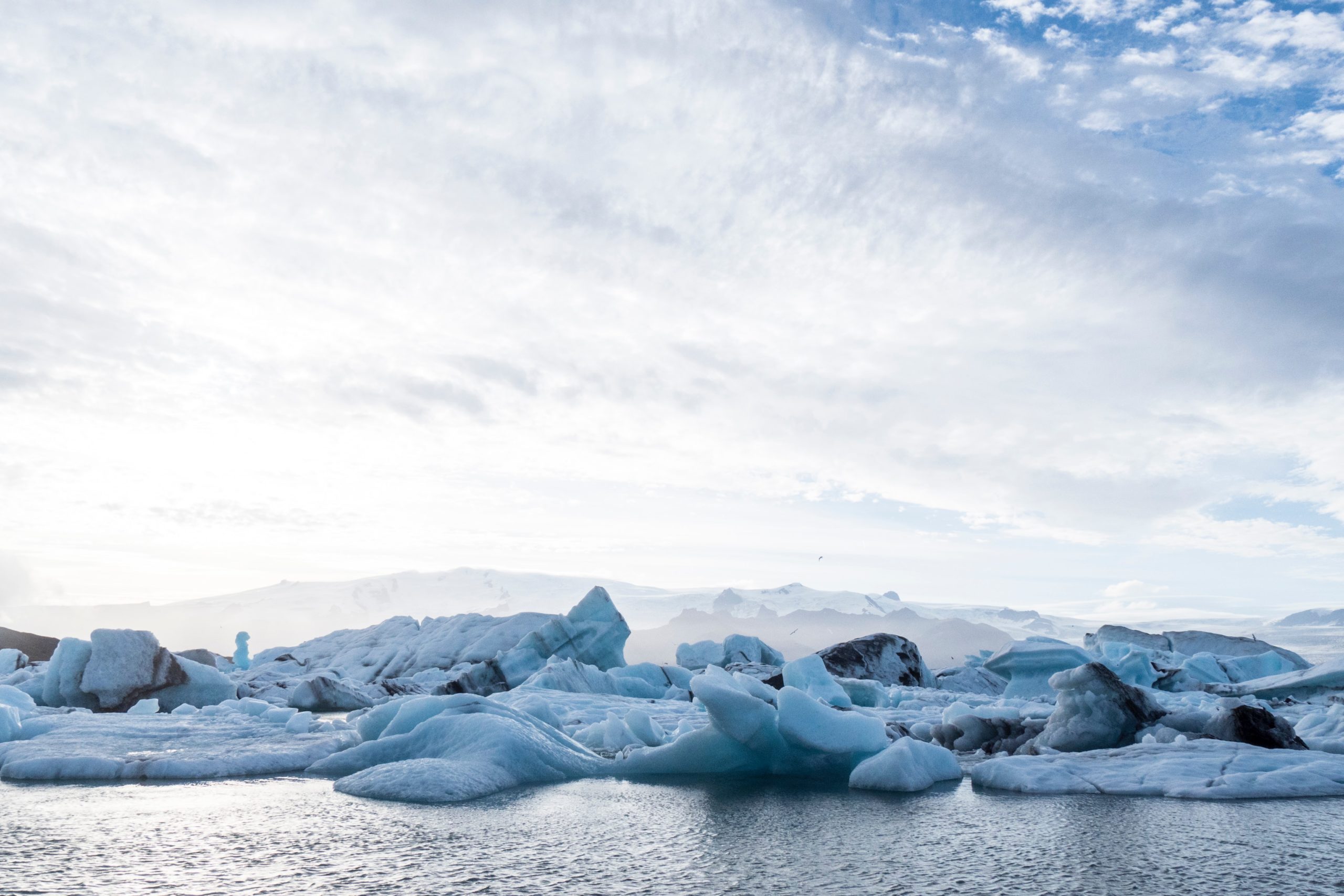
4. Jökulsárlon and Fjallsárlón
You have likely already seen Jökulsárlon on lists like these, and it is admittedly hard not to include it. One of the most dramatic glacial lagoons on the island, Jökulsárlon feeds out to sea across a black sand beach littered with giant chunks of ice.
Watching the huge pieces of ice swirl in the surf as if weightless, is a close competitor for the northern lights. But what about nearby Fjallsárlón? Only about 10 kilometers west of well known Jökulsárlon, lies this smaller more intimate lagoon.
Spectacular during the day, at night the lagoons can provide gorgeous reflection photos for aurora hunters and stargazers alike. Time spent next to these otherworldly spaces is special and fleeting.
They are truly impermanent and no repeat visit to them will ever feel the same. All the better reason to hurry- both the lights and the ice do not keep.
Tip: When visiting these spaces, be extra careful around the water and the ice. It is tempting to hurry forth and touch, but the calving of the glacier is unpredictable and can create impressive waves. The ice left on the beach is easily moved by the ocean, and just like the lagoons, can be dangerous up close. (What looks light in the sea, may feel rather heavy when dropped on your feet!)
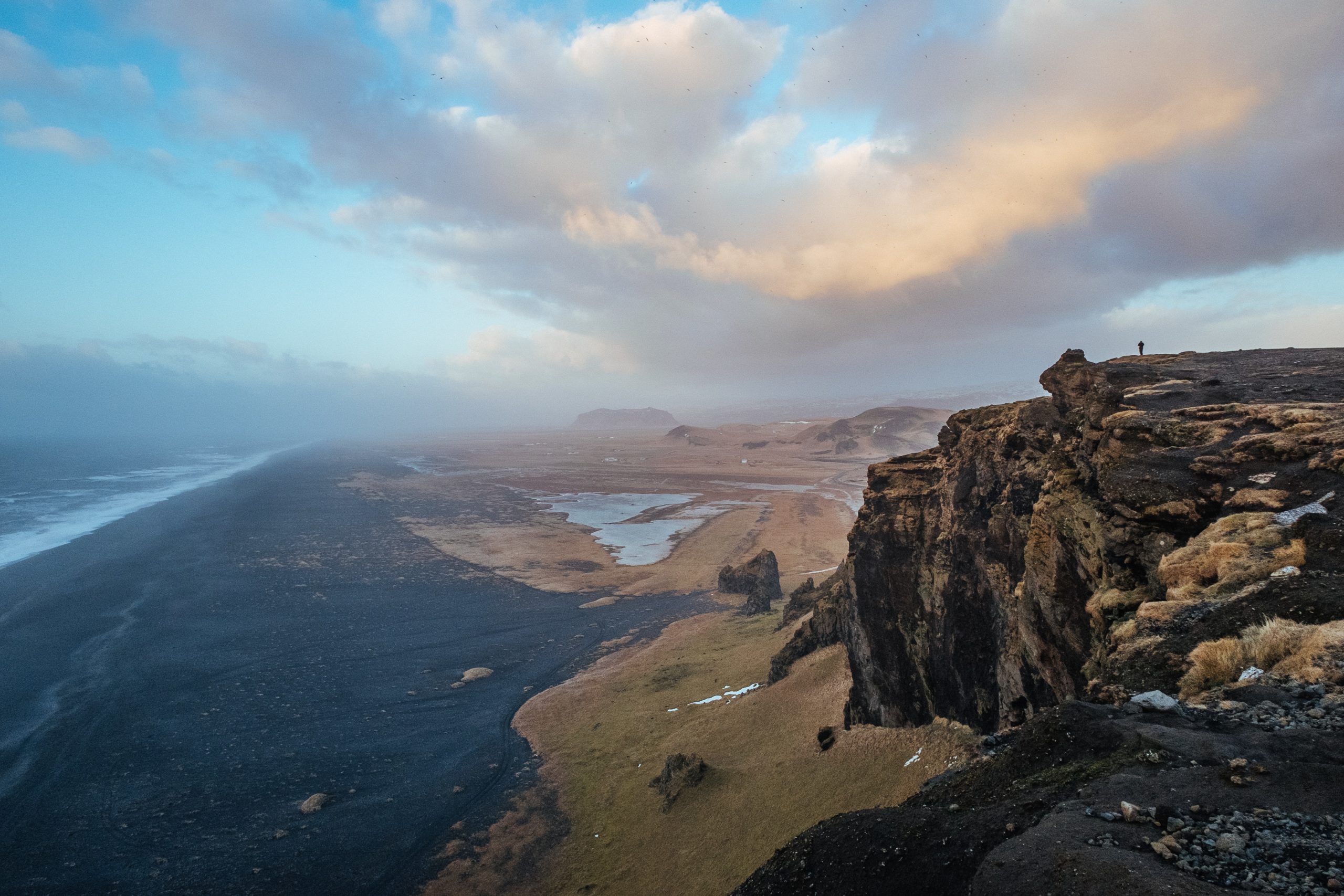
5. Dyrhólaey
Near the coastal village of Vík, there’s a promontory called Dyrhólaey. Named for the arched holes in the rock- or “door holes”, this is another ever-changing gem of the island, not to mention the southernmost point of the mainland! Featuring multiple paths, Dyrhólaey is a paradise of vistas.
There are many famous shots to be had here, and hardly anything to get in the way of them. An easy jaunt from the nearby village, Vík is a great refueling stop for explorers of this area. The south coast is punctuated by black sand beaches, huge basalt sea caves, and towering cliff waterfalls.
There are even northern light igloos that one can hide away in, which makes the south coast in general a great choice for the best place to see northern lights in Iceland.
Tip: Mind the pathways and signs when visiting this area. Dyrhólaey is changing, and pieces of the landmass are sometimes lost to the sea. Places that are roped off are roped off for a reason.
Check any signage you see before you hike out, as rangers in the area often update it due to shifts in the conditions of the land.
The ocean around this area is fierce and has claimed many lives. When visiting the shoreline, keep your distance from the waves- this beach is known for “sneaker waves” and unforgiving currents.
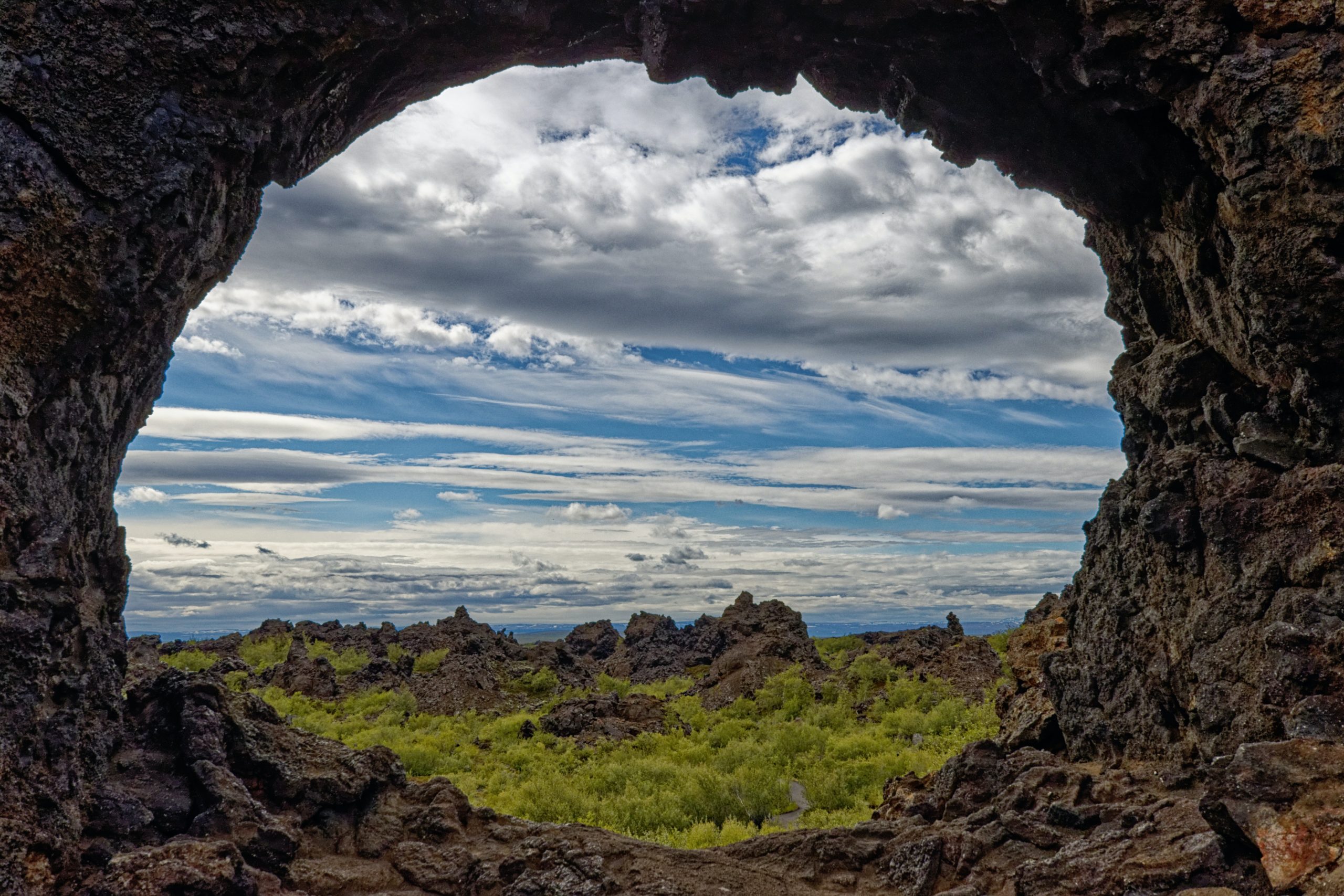
6. Dimmuborgir
In the north of Iceland near Mývatn, lie the dark castles. Otherwise known as Dimmuborgir, this strange lava field has captured the eye of many, from Norwegian metal band Dimmu Borgir, to the wildlings of Game of Thrones.
Characterized by the unusual rock stacks and tunnel formations, Dimmuborgir is a place of many stories and beliefs. But, regardless of what you believe, it is a shoe-in for best place to see northern lights in Iceland.
Being located in the picturesque Mývatn region, the dark cities overlook miles of great lakeside hiking and some of the north’s best geothermal bathing. For amateur and expert photographers alike, the craggy peaks of the lava and the still waters of Mývatn make incredible photos against the bright colors of the auroras.
Between the breathtaking natural wonders and the nearby amenities, it’s hard to find a better spot!
Tip: Visit this place during the daytime to familiarize yourself with the terrain. Mývatn may not be hugely difficult hiking, but these rocky areas can be challenging to navigate for the first time in the dark. Double up on your protection by bringing a headlamp or torch- extra points if it’s a red light for night vision preservation!
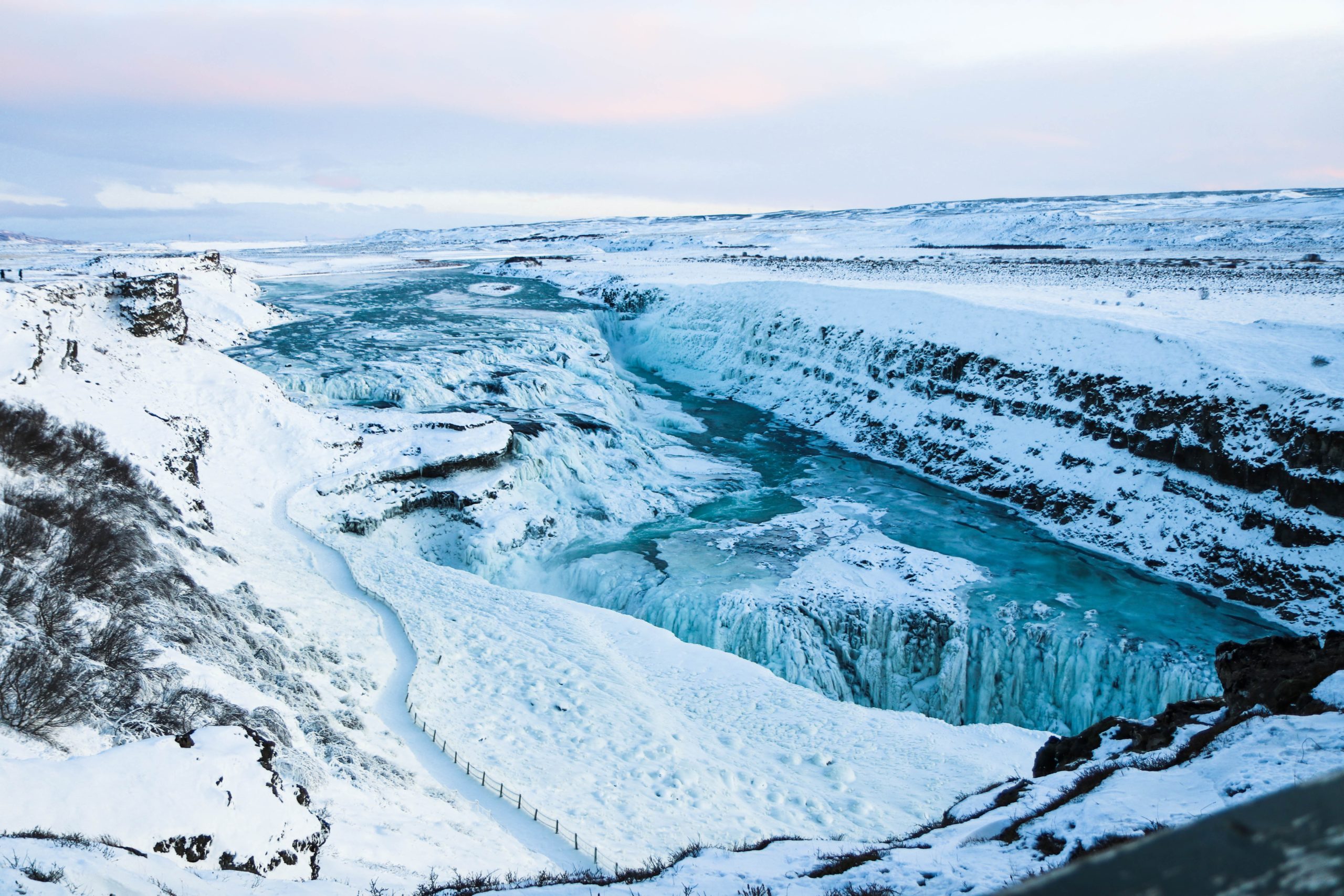
7. Gullfoss
Imagine reclining on a bench watching the northern lights, while a waterfall rumbles nearby. Doesn’t get any more peaceful than that! On our hunt for the best place to see northern lights in Iceland, we had to include a waterfall. Iceland is simply riddled with these gifts of nature, and Gullfoss is a big one.
Named for its golden illuminated appearance in the daytime, what is even more spectacular is the light that hits it in the nighttime. About 1 hour and 45 minutes from Reykjavik, Gullfoss is a protected area that hosts observation points, walking paths, and a parking lot with a cafe.
It’s rare to find a good aurora spot with a safe place to park your car, so spots like these should not be overlooked. The golden circle region is a great daytrip, and the roads are well maintained in the winter months.
Tip: If you plan on visiting the cafe or shop on your trip, make sure to check ahead and see what the hours are. These things can vary depending on the season, so it’s better to go in with no surprises. (Or at least one less- the lights are a big enough surprise on their own.)
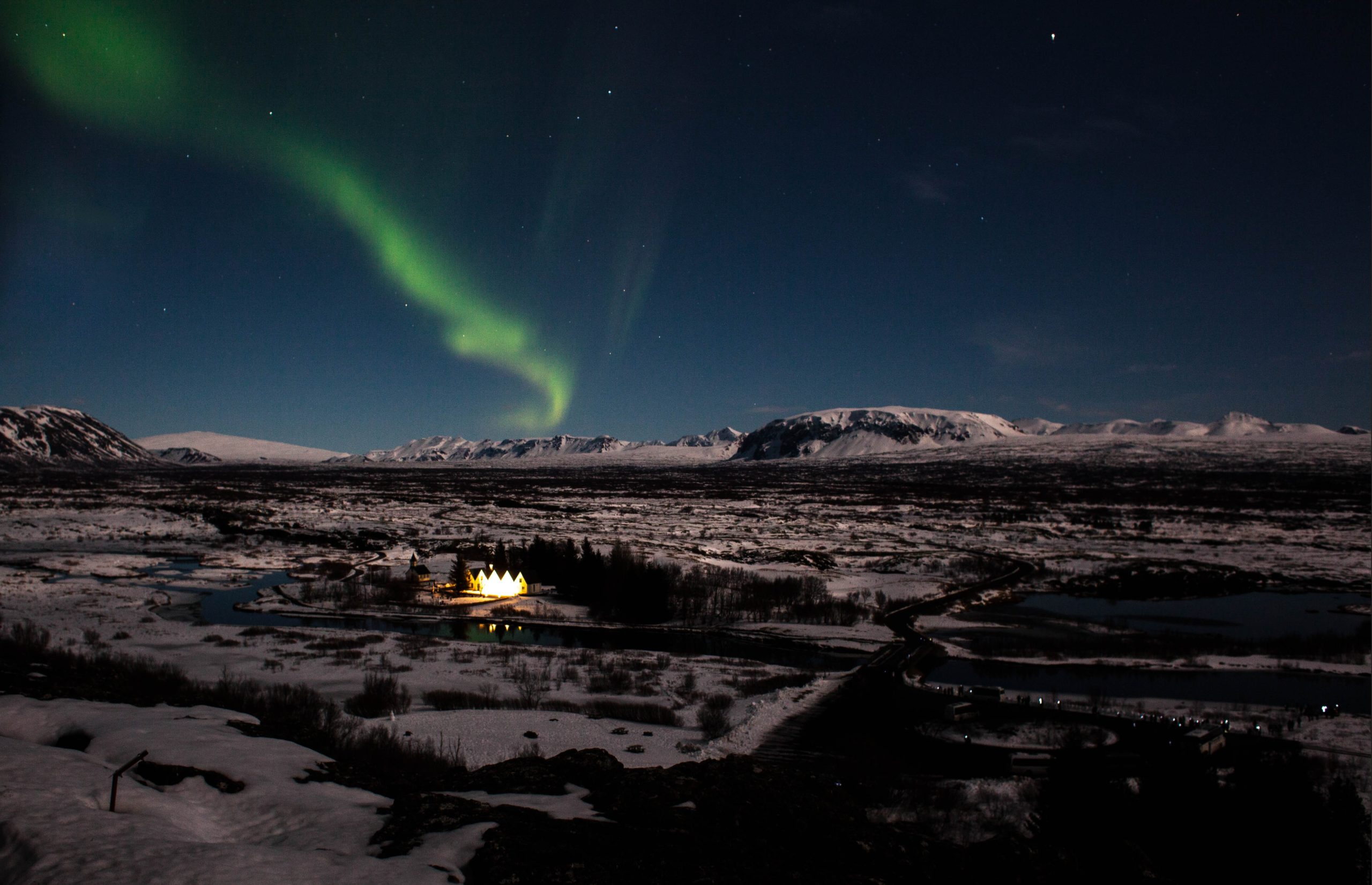
8. Þingvellir National Park
Only about 35 minutes from the capital, Þingvellir or Thingvellir should be on the top of your list for best place to see northern lights in Iceland- no matter where you’re staying. Once upon a time, Thingvellir was the most important gathering point for Icelanders, and it isn’t hard to see why.
Home to a massive lake, miles of hiking, and incredible views- Thingvellir is a place of activity. It’s also one of the places where you can see the continental rift! But as far as lights go, it’s a veritable playground.
When you’re out aurora hunting, you have to consider logistics. Things like places to park, places to get a snack, bathrooms, proximity to lodging, access to darkness, and so on. Most places will only have a few of these, but Thingvellir hits them all.
Being a national park, it’s designed to accommodate vehicles and wanderers. There are loads of paths to travel, established hiking routes, and plenty of parking lots and observation points to safely stow a vehicle.
This is a big win, because Iceland is full of narrow roads with few places to pull over for a show. Thingvellir is also aware of us aurora hunters, and so there are occasionally places to grab a coffee or a bathroom break along the way.
(Depending on how late you’re out, of course. Double check this before you go if it’s your destination.) You’re also in a great spot when you’re here. Thingvellir is just a half-hour north of Reykjavik, and rests at the entrance to the Golden Circle region. (Or exit, if you came the other way!)
And even though you’re close to town, you will find that Thingvellir is home to some surprisingly good darkness. Because of its inland location and its historical importance as a gathering point, it’s well-positioned on the edge of the highlands.
And there’s tons to do! The only mistake you can make by aurora hunting here is to skip visiting in the daytime. In the autumn, Thingvellir is a rainbow of foliage.
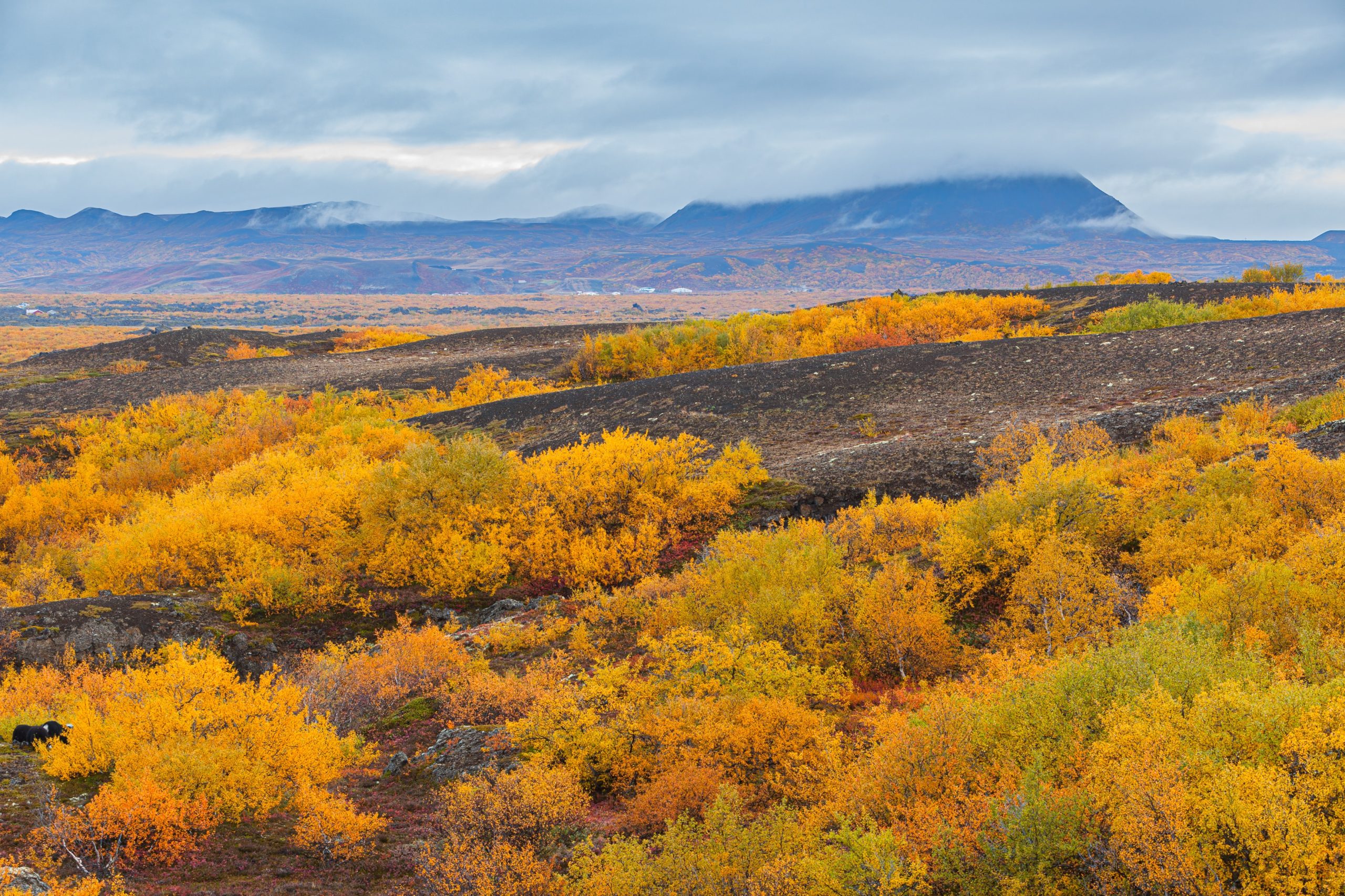
9. Ásbyrgi
This is a rarer stop in the north of Iceland. Located on the Diamond Circle, Ásbyrgi is a horseshoe-shaped canyon that some believe was made by a glacier.. But really we know it is where Sleipnir touched hoof to Earth.
The views to be had here are unique, as the steep walls of the canyon protect a vast forest within their embrace. Because of this “Shelter of the Gods”, Ásbyrgi is an incredible place to visit in the autumn months to catch the color changing of the leaves, and the crystal pond among them.
There is a campsite here, and multiple trails to enjoy all the different views that the huge canyon has to offer. But be careful while you’re here- to us this may be the best place to see northern lights in Iceland, but to some it is the elven capital. Tread lightly!
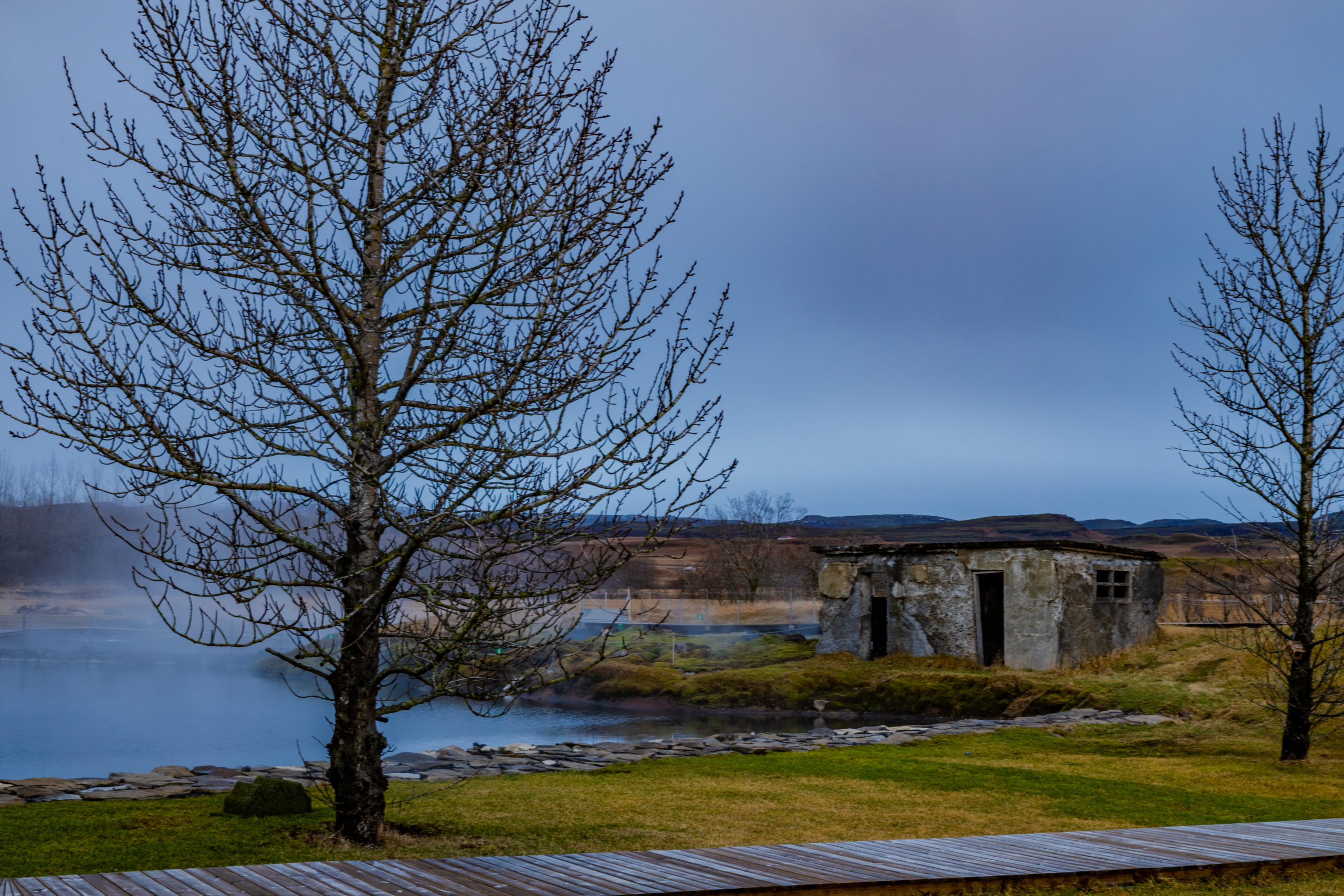
10. Gamla Laugin: The Secret Lagoon near Flúðir
The truth about the best place to see northern lights in Iceland, is that it will change with the weather, and with your expectations. Maybe you have a certain photo you want to get, or a certain thing that you want to see. Maybe you want to stay in a specific region, or are looking for cozy places to unwind while you you look.
Places like the Secret Lagoon near Flúðir, perhaps. We are pretty big fans of watching the lights from warm places, and this is one of the warmest. If your plans and the weather both allow it- watching the aurora from a natural hot spring is an incredible experience.
Particularly one as beloved as the Secret Lagoon. One of Iceland’s oldest “swimming pools”, this is the place where many southern Icelanders first learned to swim.
And within 24 hours, it has replaced its own water as it continuously flows. One of the most authentic bathing experiences there is, coupled with one of the most authentic aurora watching spots we know.
Tip: Check the website before you go to see what the conditions are for that day. Depending on traffic, you may need to book in advance. (The lagoon is big, but it is always better to plan ahead if you can.) The hours of the lagoon may change, so double-check the schedule to see how late they’ll be open when you visit.
When can you see the Northern Lights in Iceland?: 5 useful tips for planning your adventure
"When can you see the Northern Lights in Iceland?" is the question on the tip of everyone's tongue. The minute you step off the plane in the land of fire and ice, it's time to start looking up. Or is it?
What are the Northern Lights?
Before we get to the “When can you see the Northern Lights in Iceland?” half of the show, let’s talk about what we’re actually looking for. In a country of natural wonders, the Northern Lights are one of Iceland’s greatest treasures. A phenomenon based on volatile space weather, the Aurora Borealis happens when solar activity from the sun travels over our planet and collides with our magnetosphere. This meeting of forces gives some of the super-charged gas in the solar storm an opportunity to travel down the magnetic field towards the poles, creating another collision with oxygen and nitrogen pockets in our atmosphere.
This clash creates the colorful visual byproduct of the aurora- an accidental gift of the cosmos. Because this is a polar occurrence, it takes incredible strength for the storm to grow large enough to travel closer to the equator from the pole, which is why we primarily see the aurora in very northern or southern lands.
Every so often we get lucky, and the sun sends a sizeable storm, giving us the rare chance to view the Northern Lights from places like North America and continental Europe.
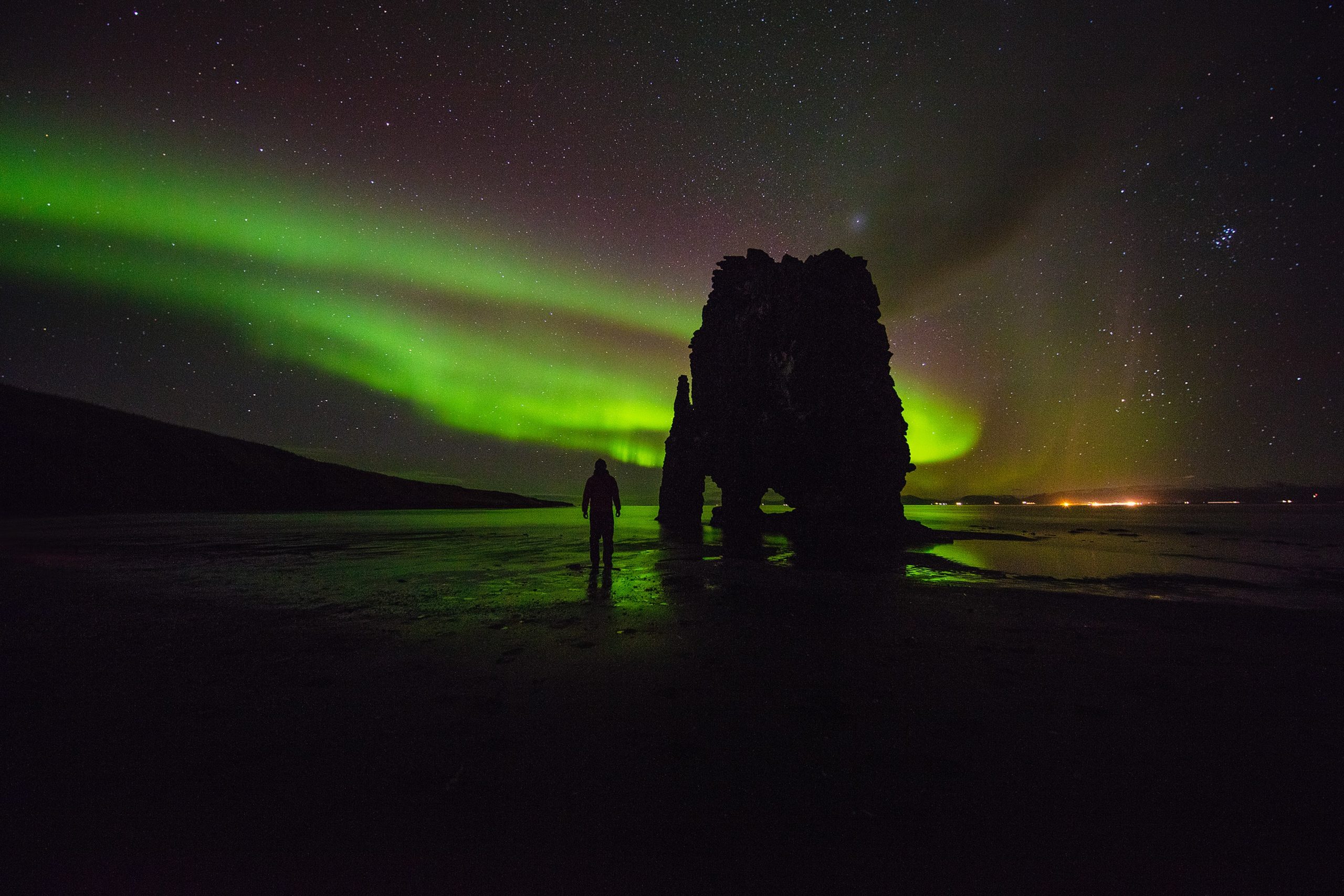
Life under the polar light cycle: Choosing the right half of the year
Planning a northern lights vacation can be challenging, as nature tends to run on its own schedule. A good place to start, is to know which half of the year is aurora season in Iceland.
Because polar lights happen far above us in space, it is possible for them to occur at any time of year. Many people mistakenly think that they are related to cold weather, but, luckily this is not the case. Because of how the Earth tilts in its orbital path, the winter season in countries around the northern pole coincides with shorter days. You may have a similar light cycle situation during winter in your home country.
In a country closer to the pole, this light cycle is a bit more exaggerated and can result in days where the sun does not rise for a period of time. Iceland’s winter light cycle is not quite as extreme, but due to this trade-off, we experience a surplus of daylight hours in the summer and a surplus of dark hours in the winter.
This means that in the summer, it is much too bright for us to pick out auroral activity in the skies. There may be solar activity and auroras happening, but we would be unable to see them. Despite their appearance, we require solid darkness to view an aurora from Earth. (If you’re riding along on the International Space Station, however, you might be one of the few people that could view a July aurora!)
But for those of us down here planetside, we must wait for optimal darkness to be able to pick out auroral activity with the naked human eye.
The Northern Lights occur at a low lumen, so sometimes even a weak occurrence can be hard to pick out in perfect conditions. (A good camera can help you out with this, as the camera’s vision capabilities are not quite so limited in darkness.)
Fortunately, this extreme light cycle buys you an entire half of the year to plan a Northern Lights holiday in Iceland- which gives you more time than you might think.

August to April: The Auroral Season
Because of this light cycle, the Northern Lights season in Iceland runs from August to April. August is very early in the season, and typically we access amenable darkness by the end of the first week. However, if you are planning a vacation, it is recommended to wait until the end of August for optimal conditions.
The end of the first week of August is the earliest we have seen an aurora, but it is not generally expected and would be a risky time to plan a trip. In recent years, tours have started mobilizing for their aurora seasons at the middle to end of August, with some starting as late as September.
This August to November time frame puts you in our autumn season. Not a time typically associated with auroral viewing, the transitional seasons like fall and spring are phenomenal times to hunt for Northern Lights. These are moments in the year where colorful changes are occurring in the countryside, and often, low traffic among visitors.
These are some of our favorite times to look for aurorae, particularly because there is milder weather, manageable light for other outdoor activities, and gorgeous scenery. As you can see, the auroral season runs all the way to April. In Iceland, April is traditionally considered the beginning of the summer season (if you can believe it), so the same rules that apply to August apply here.
If you are interested in a spring aurora hunt, you will want to be careful of booking too close to April, as mid-April is too bright for aurora viewing typically. In a lucky year, professional photographers have managed to grab some surprising shots throughout April, but this would not be advisable for someone that is planning an aurora trip.
The month of March is often quite good throughout, weather permitting, and people have been known to get lucky in the very beginning of April. Once we near the middle of April, the island moves over to summertime in earnest, and the midnight sun begins to return.
This gives you quite a spectrum of time to hunt for auroras, and this season spans autumn, winter, and even spring. This means that you can tie your aurora aspirations together with additional activities, like horseback riding, hiking, ice caving, or even skiing.
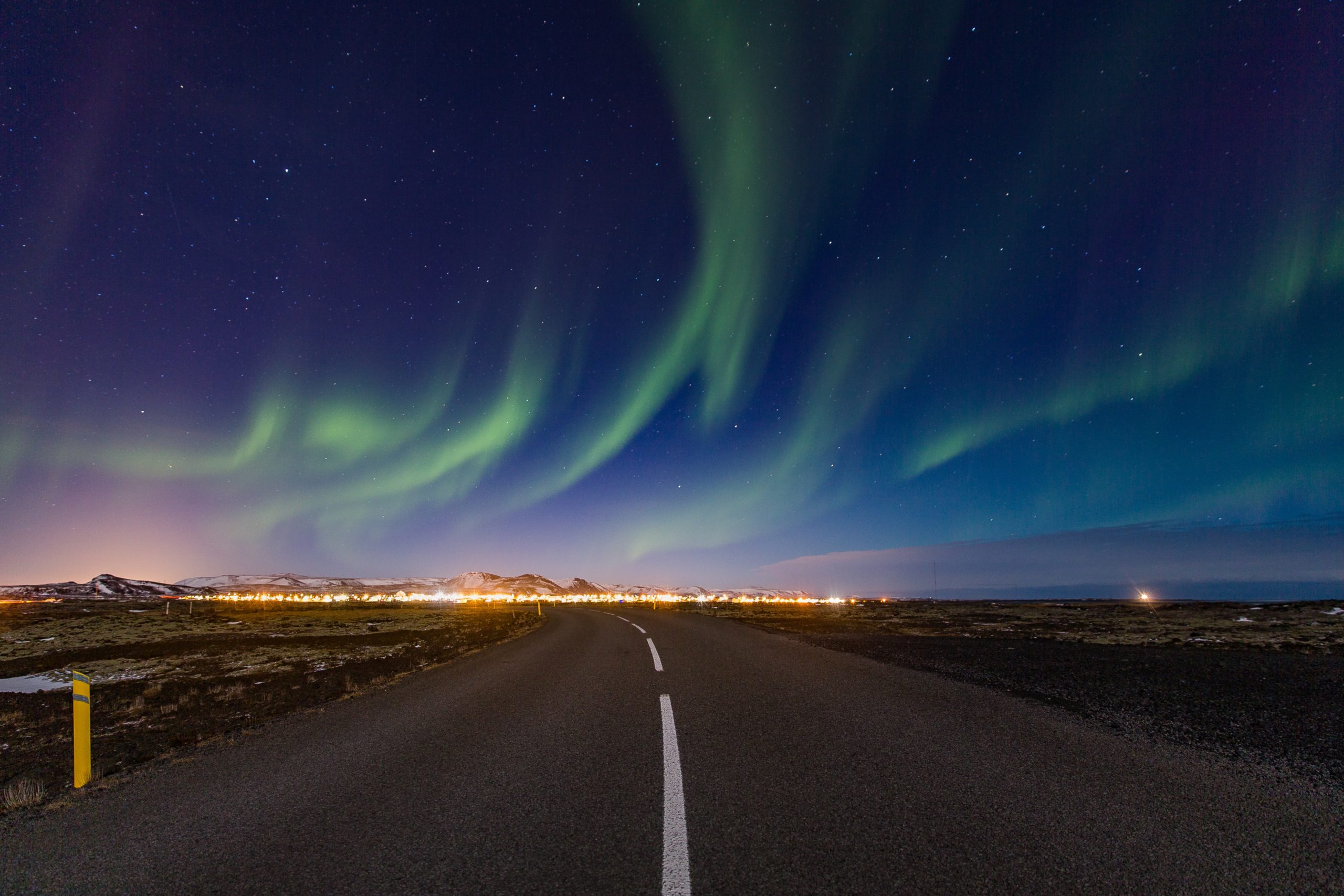
"Hello darkness my old friend": Aurora watching under the cover of night
You’ve got an entire half of the year to plan your trip in, but what time does the aurora show up? This is another popular question, and the answer does change a bit depending on the time of year that you visit. For folks visiting earlier or later in the season closer to autumn and spring, you’ll find that there are fewer dark hours available for hunting.
In Iceland, you are losing or gaining minutes of light every day, depending on if you are moving away or towards midsummer or midwinter. If you’re visiting us before December, you will be losing 3-4 minutes of daylight on average every day.
After midwinter, you start to gain those minutes of daylight back. If you stay with us for a week, you might even notice a difference by the end of it! Because of this, you will find that guided experiences start a bit earlier (closer to 8:00 PM) in the autumn and spring, and a bit later 9:00-10:00 PM) in the winter months.
Like all aurora figuring, this can vary on the occurrence itself. A powerful solar storm may cause a brighter visual manifestation, thus making it possible to view earlier in the evening. However, despite the fact that you’re watching in the correct half of the year, we still require this high-quality nighttime darkness for visibility.
This can be a confusing detail, especially if you’re visiting us in December when the sunrise is closer to 11:00 AM and the sunset is nearly 3:00 PM! One might think, “If the sun has set by 4:00 PM, why can’t I see the aurora already? Isn’t it night?” Despite the early setting of the sun, we do still cycle through steps of “twilight”, or “dusk”.
You may be familiar with this if you enjoy maritime sports or navigational pursuits like flying or sailing. So despite all this extra darkness in the high point of winter, we still wait for proper nighttime in the later evening. Averages for optimal visibility may vary per person, but typically we can expect that on a good night our window will be around 10:00 PM to 1:00 AM.
Can an aurora happen outside of this time frame? Absolutely! On a phenomenal night, you might catch one at 8:00 PM! And likewise at 3:00 AM! The excitement of this phenomenon is that no two aurorae are ever the same- and neither are the experiences that lead you to them.
Like many sciences, very few things are permanently definite- so if you feel that you have exceptional darkness, clear skies, and a forecast indicating solar activity, have a look! These things do tend to sneak up on you when you least expect them.
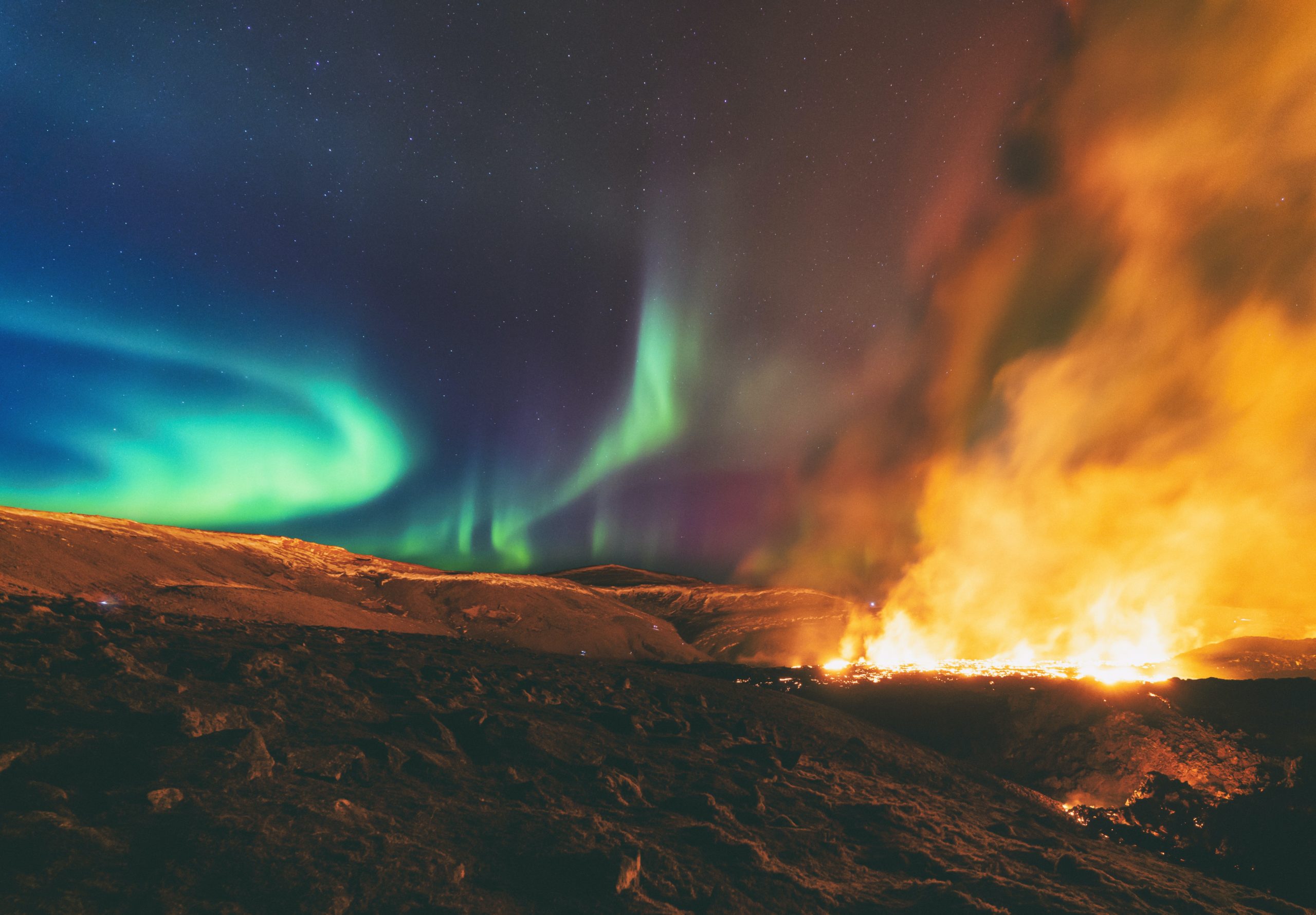
The right place at the right time
So you’ve got an idea of when the Northern Lights can be seen in Iceland, but where should you go? Where can you see Northern Lights in Iceland? The truth is, there is no singular good spot.
This is lucky for us in a way because it means we’ve all got a fair shot, no matter where in Iceland we’re watching from. As far as darkness goes, it is advisable to move away from light pollution if you can. The greatest centers of light pollution in Iceland are still manageable enough for auroral viewing, and won’t impede you to the level of a massive metropolis- but if you can find yourself a patch of true dark your vision will adjust better and your viewing experience will be improved.
Watching near a streetlight or a house can make low light photography a bit harder to balance, and it can also cause your eyes to struggle with adjusting to their own night vision. When viewing a similar auroral occurrence, people in a brighter area may report seeing less of the aurora, or a dimmer or less vibrant color.
In a truly dark place, your eyes will be able to pick up some of the finer pieces and “shards” of the occurrence, and typically be more successful at discerning the color.
If you’ve got a camera, don’t forget to snap a few low light shots- you’d be surprised how much better the camera’s “eye” sees compared to our own! When looking for a good spot to wait for the Northern Lights, you’ll want to consider cloud cover. On an auroral forecast, you can see that the cloud map is an integral part of finding out if you’ll be able to view activity or not.
Because the Northern Lights happen above our weather system, we miss out on any light shows that happen on cloudy evenings. The good news about this is that cloud systems can move quickly over us on a windy night, not all areas will have the same weather, and even forecasts miss tiny windows of clarity in the sky.
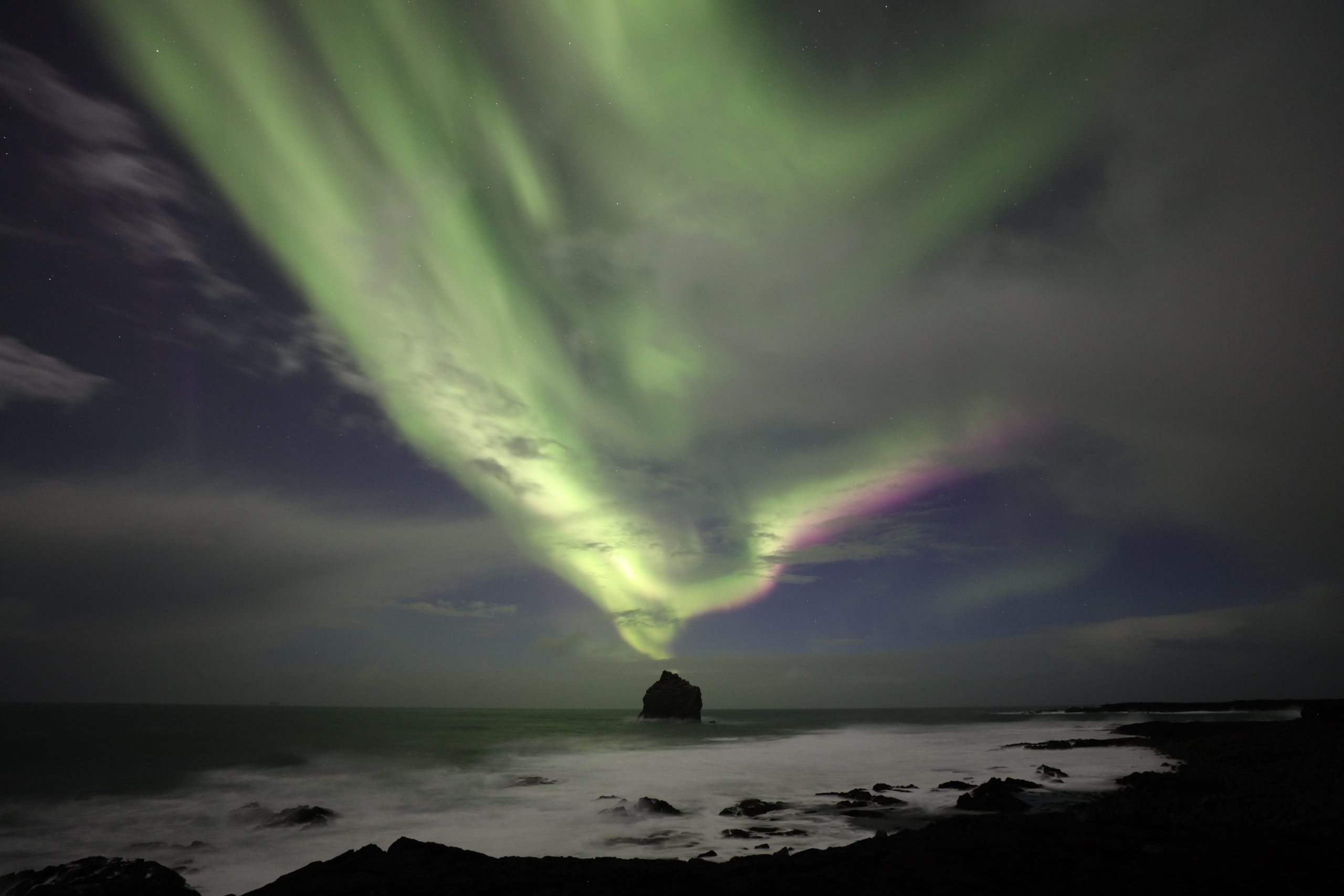
Sometimes these holes in the cloud layer are all we need to glimpse the glow- but many great activity nights have been canceled over a thick layer of cloud cover. If you’re in a vehicle and you’re able, it can be helpful to watch the forecast to see where areas of clarity may be located.
If there are clear skies around your location, you can head in the general direction of that clarity. In fact, many guided experiences will do a similar thing and will plot their course that night based on where the clarity is expected to be.
This is the best way to choose a spot, and the travel time that you spend on the way to the clear skies may also prove lucky. Covering ground and exposing yourself to different areas of the sky can be helpful since a large portion of aurora hunting is the waiting.
The longer you’re out in the dark under clear skies, the better your chances are. Because of the importance of clouds in this equation, it can sometimes mean just heading out on the road that leads in that direction. If you’re interested in finding a spot to wait in, we recommend looking for landmarks of natural importance along the way, or national parks.
Parks can be a great spot to watch from because they are designed for spectating and parking your car safely (unlike the side of the road), but be warned that many others may have the same idea. Be careful not to pull over to stop your vehicle in an unsafe location to watch! Country roads can be dark and narrow, and they do not always have a shoulder for pulling over.
It’s exciting when an aurora happens upon you in the car, but being safe and waiting for an approved pull-over location is the safest way to enjoy this gift of nature.
However, you don’t always have to be on the road to catch the Northern Lights! There are a few spectacular hideaways in Iceland just for this very purpose, where you can be cozy, alone in nature, and waiting in a perfect dark location.
For those that want to try the most comfortable hunt around, we recommend the Northern Lights igloo. Lay back on a down comforter in a heated bubble and have a drink? We can hardly think of a better way to spend the night. (Or a better photo op!)

